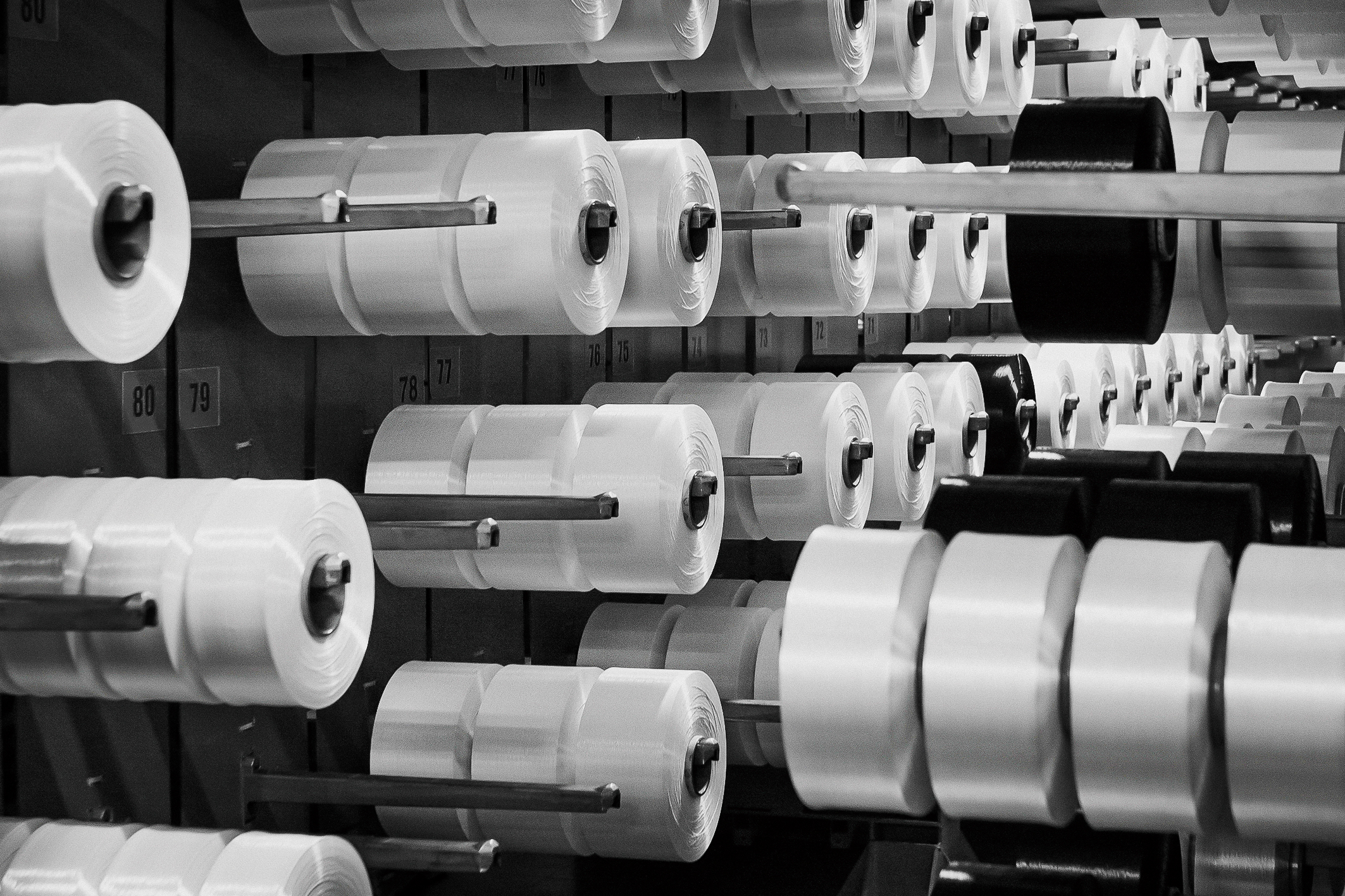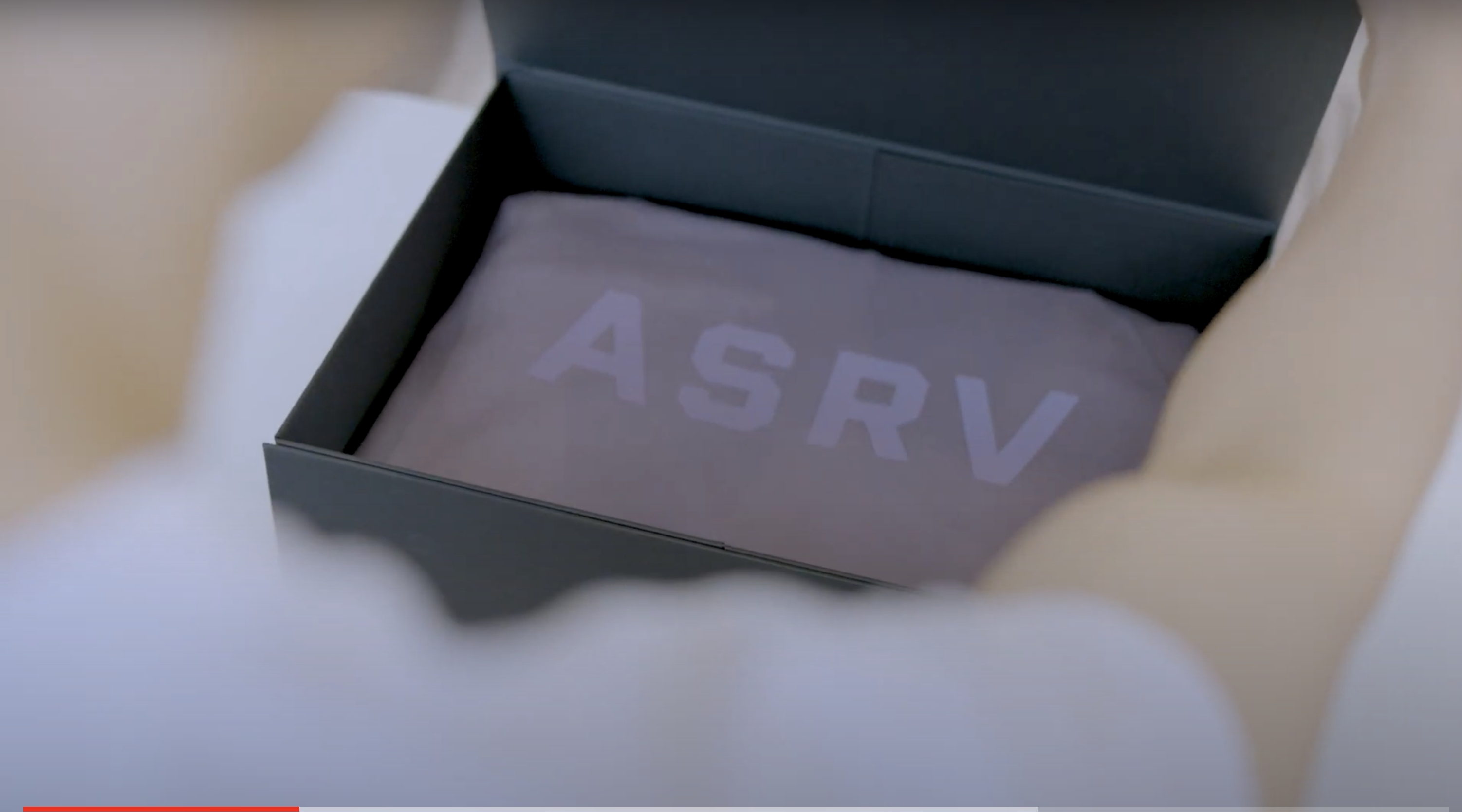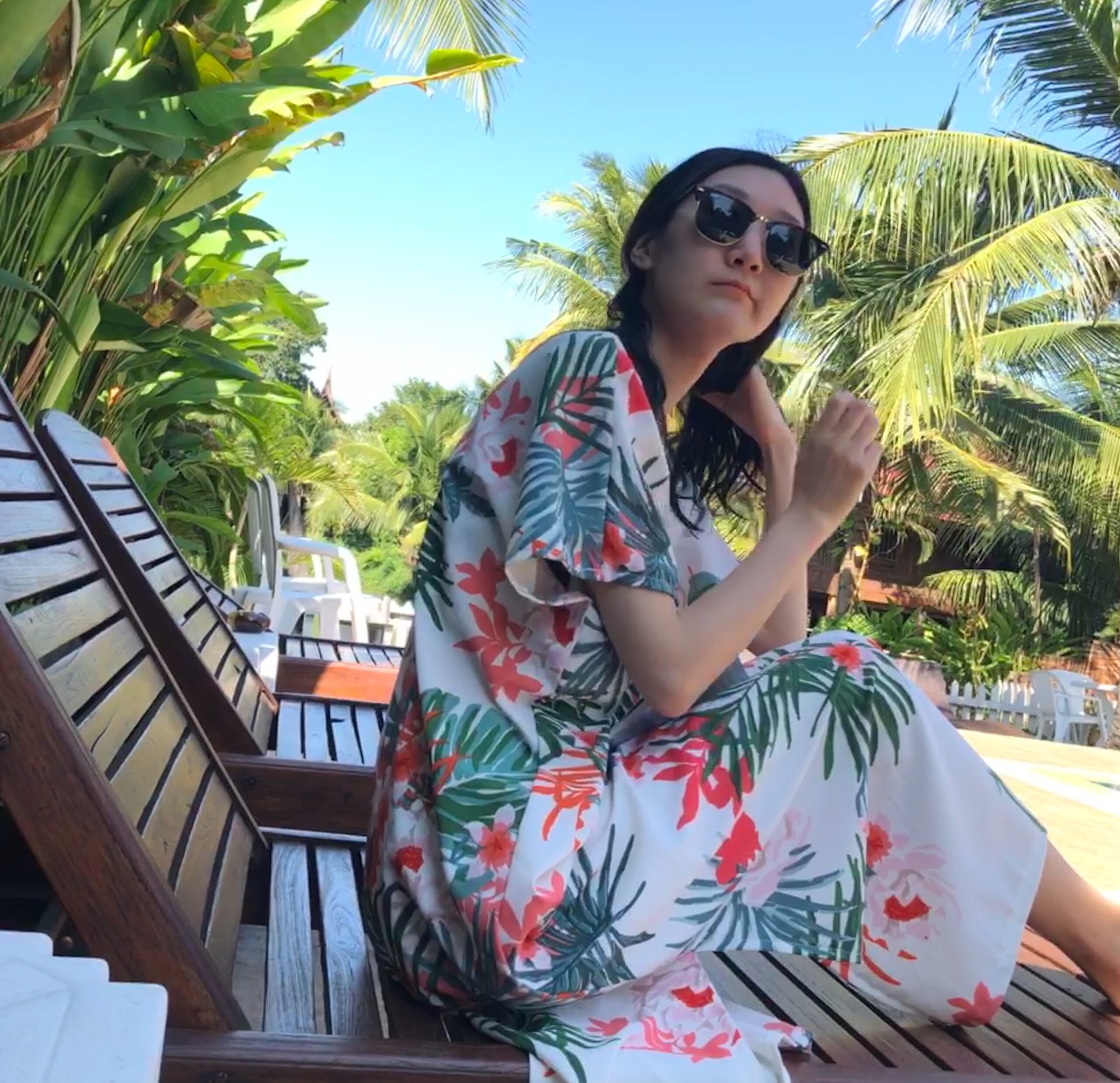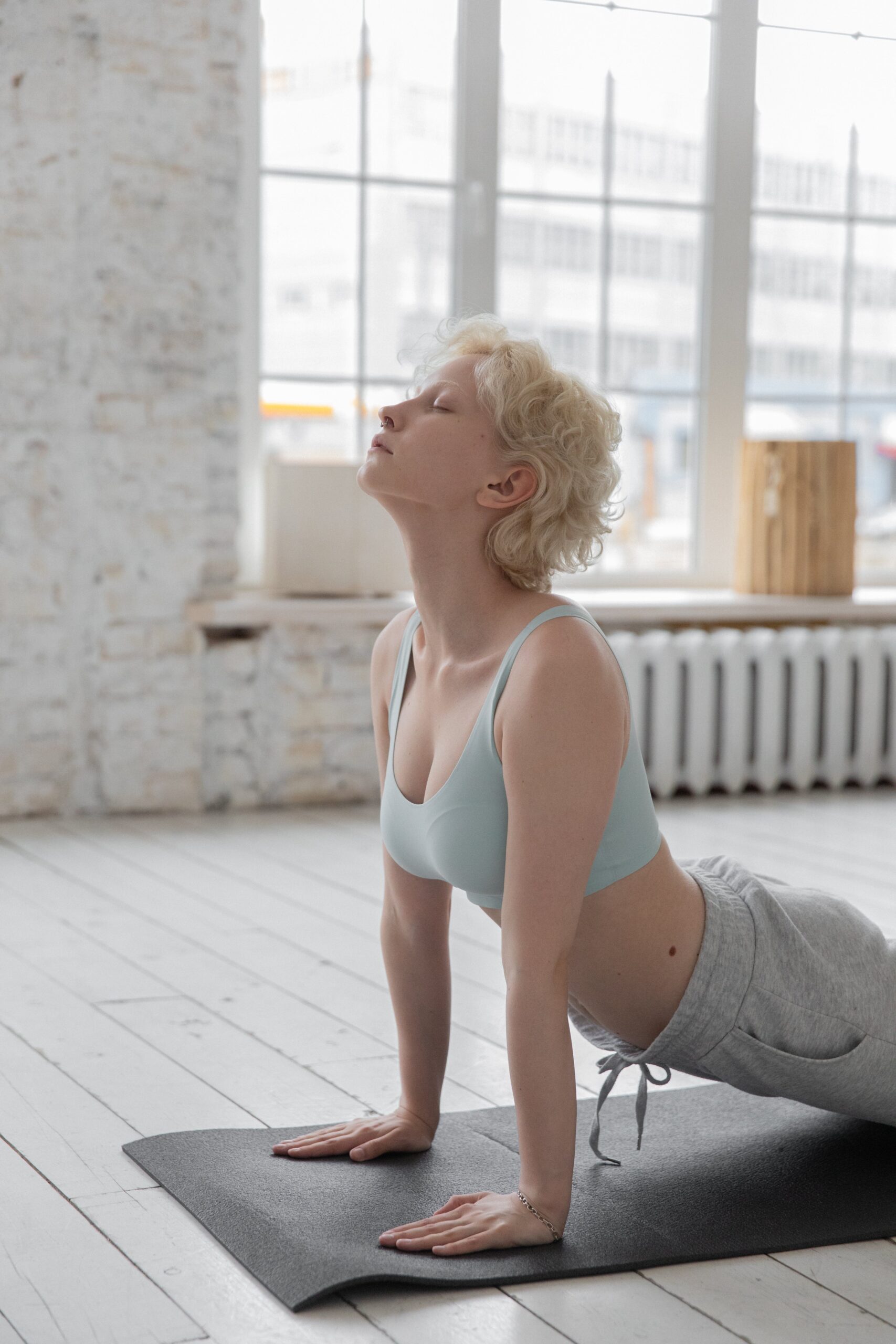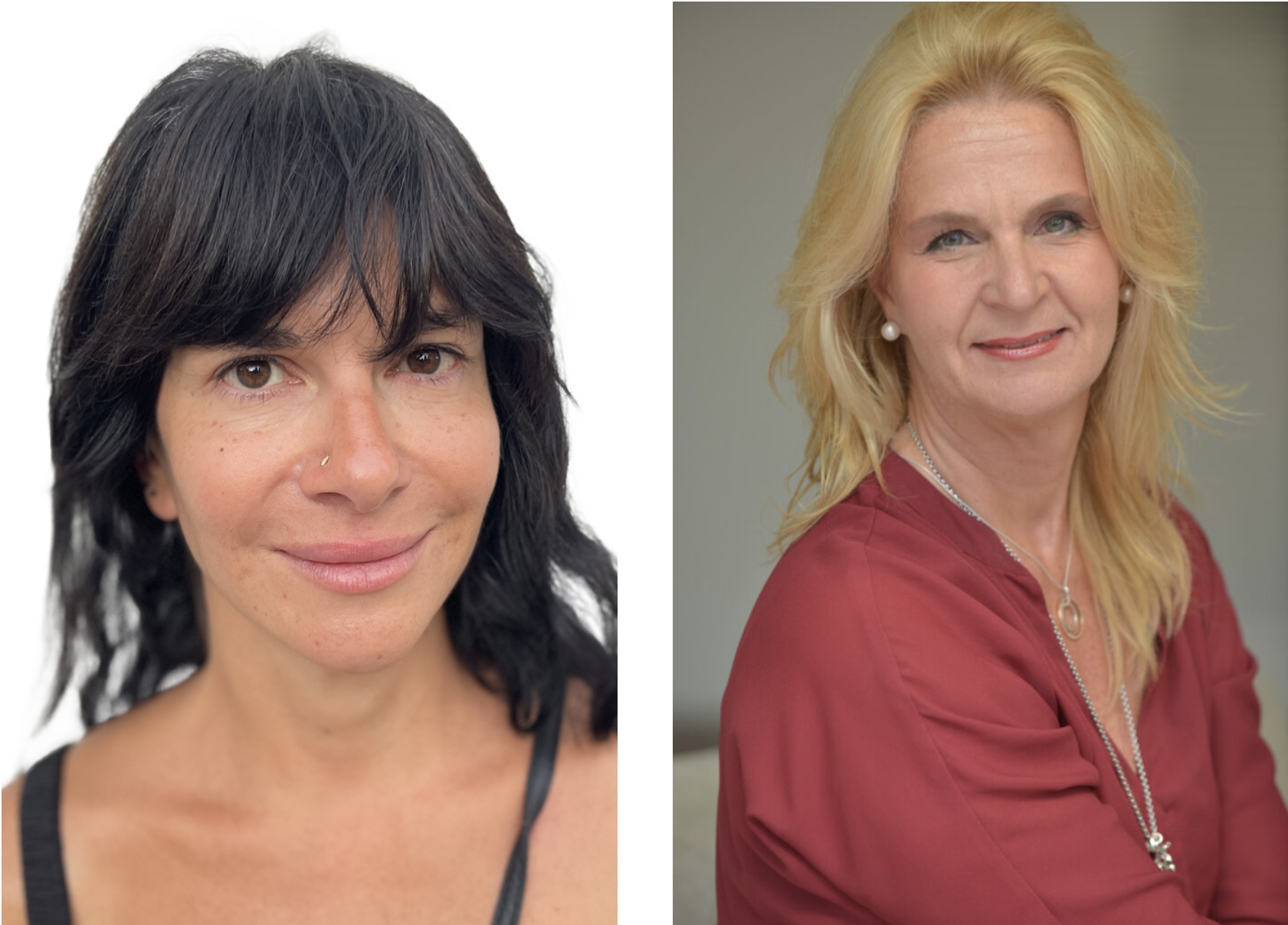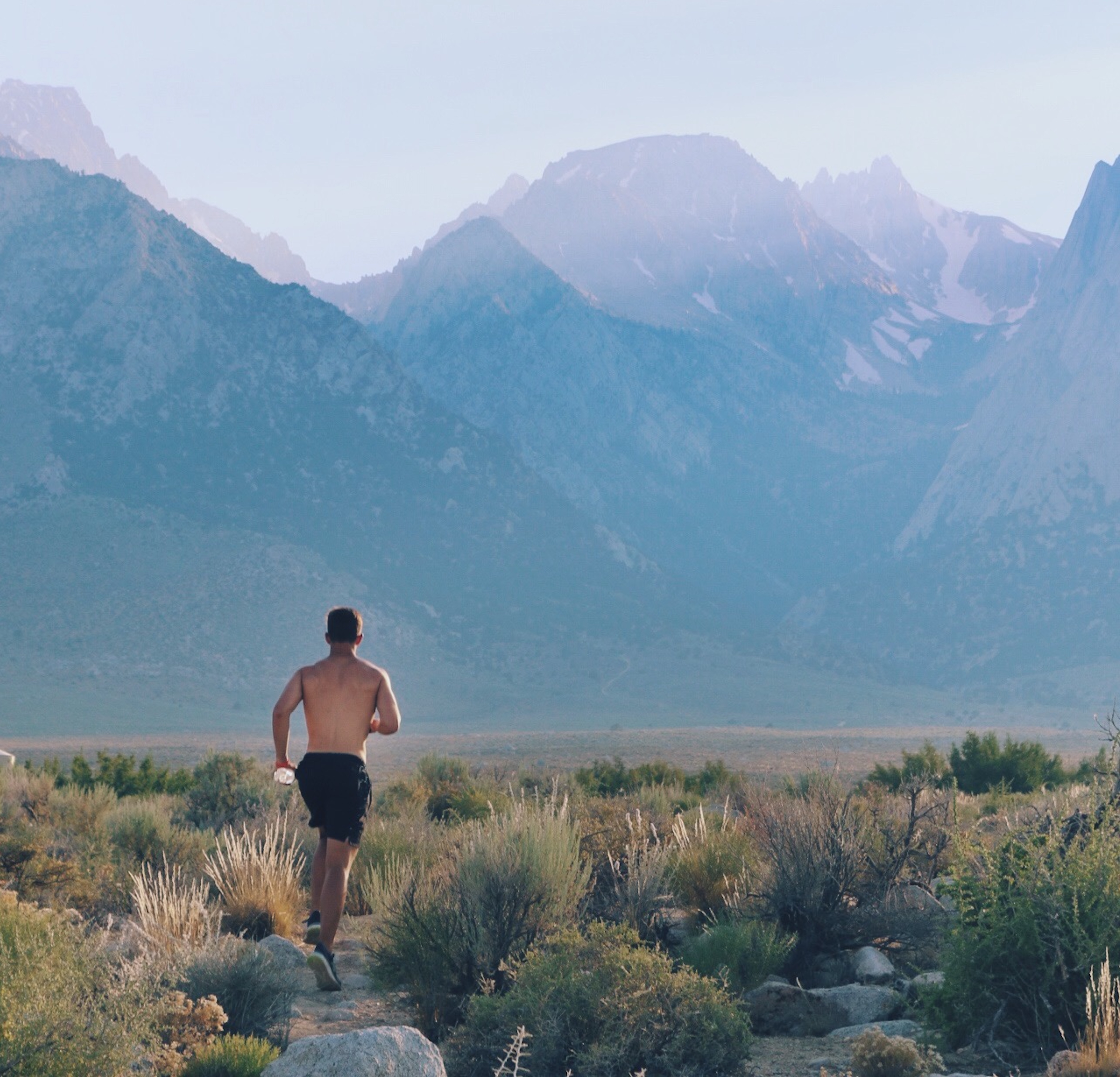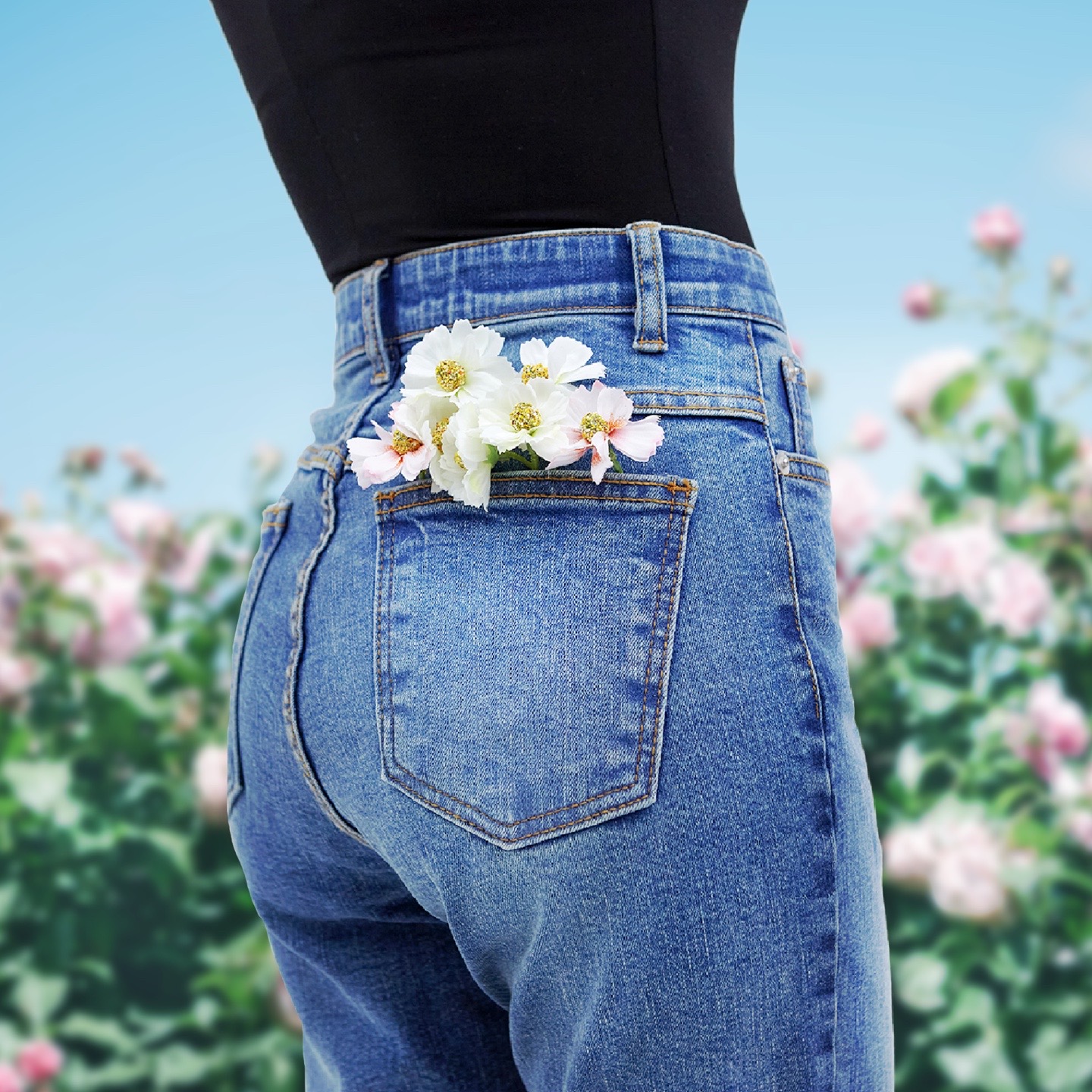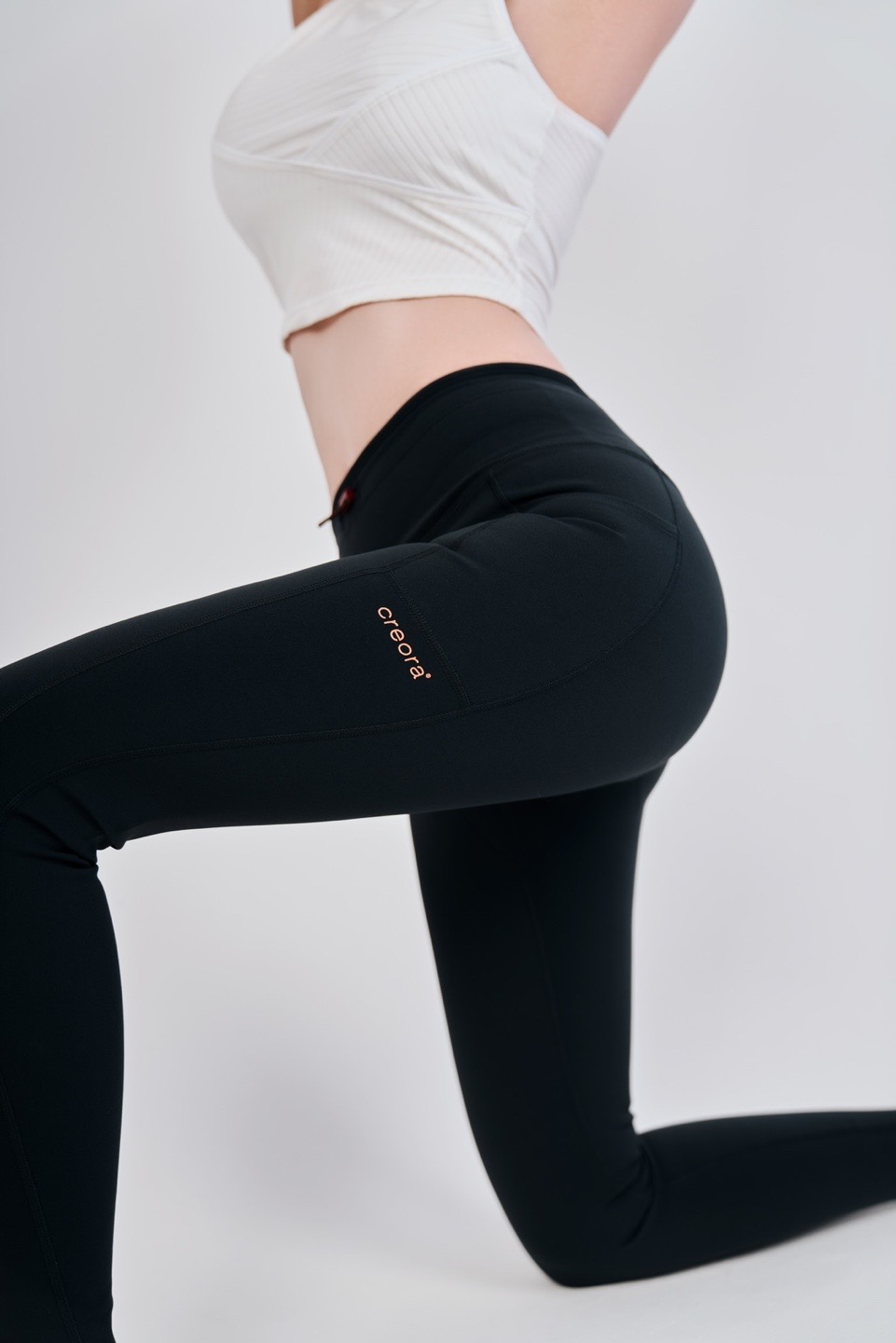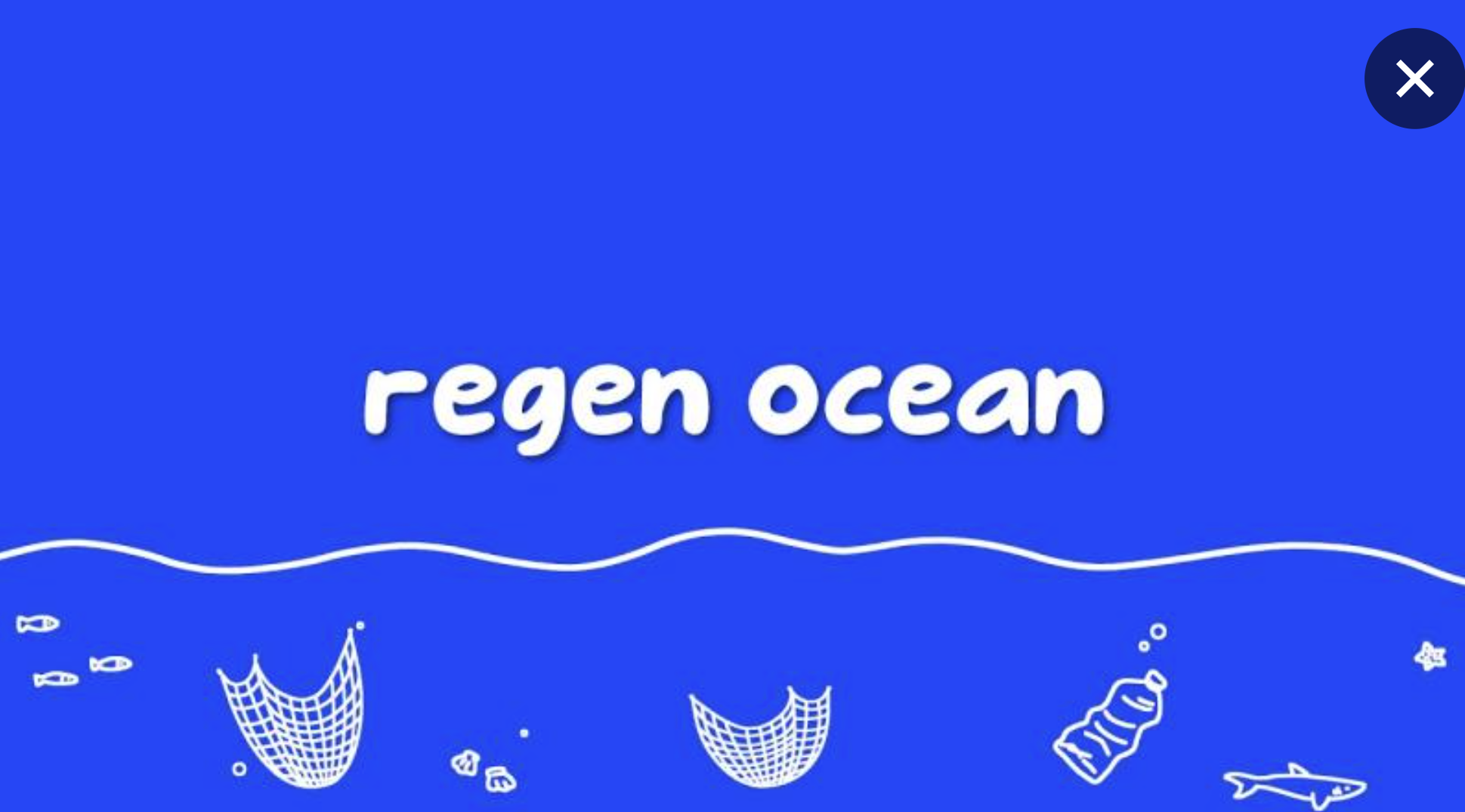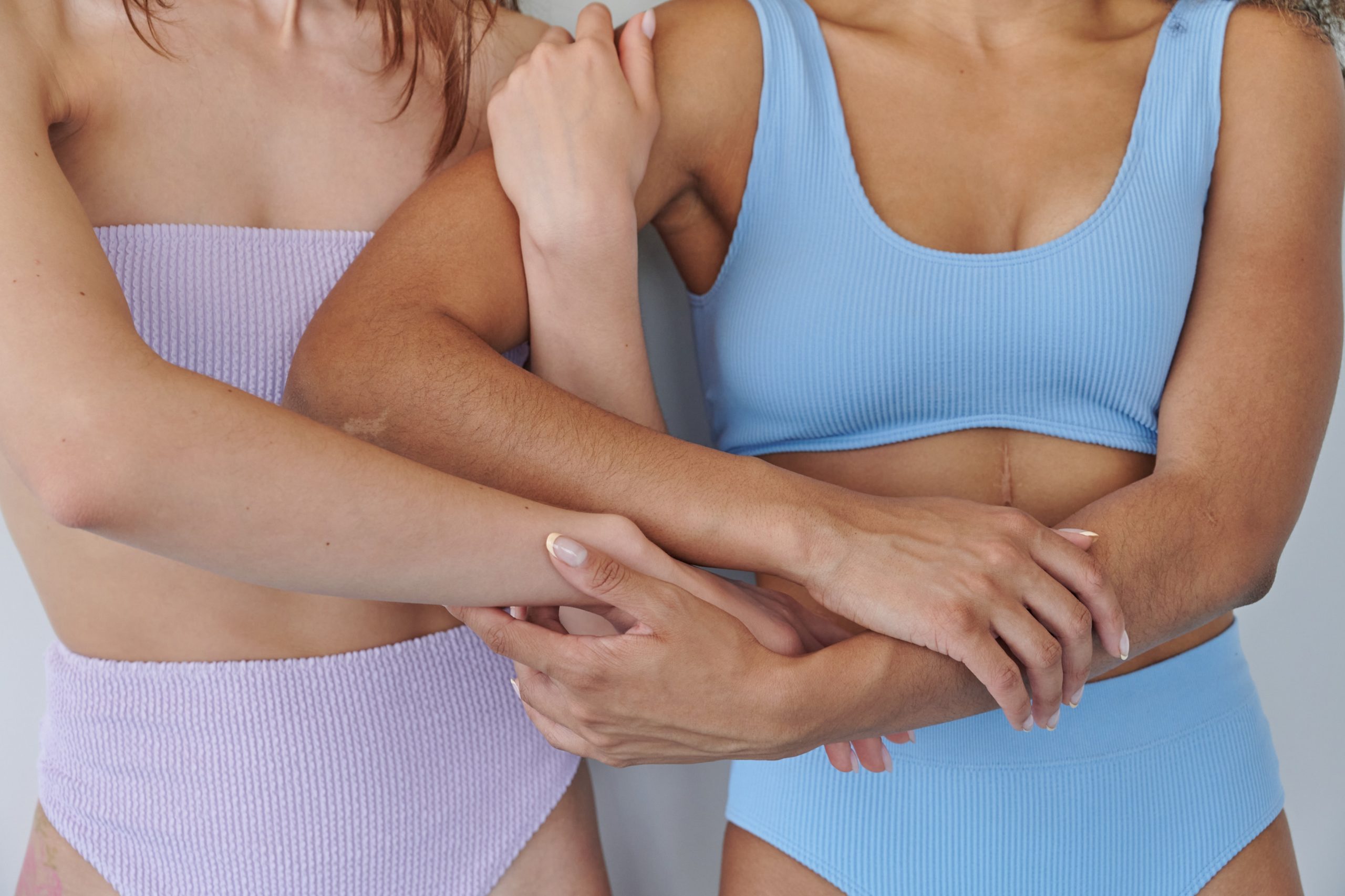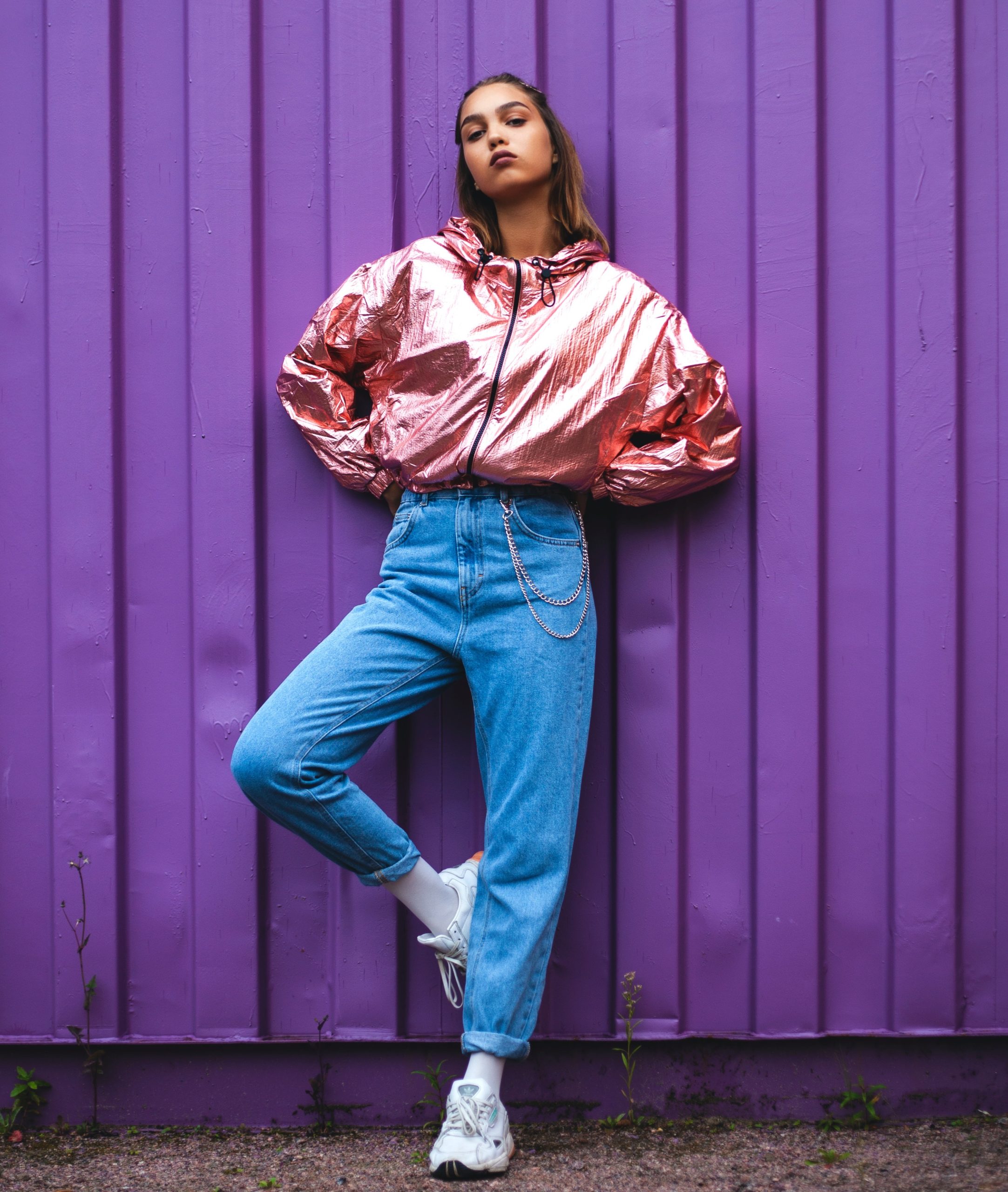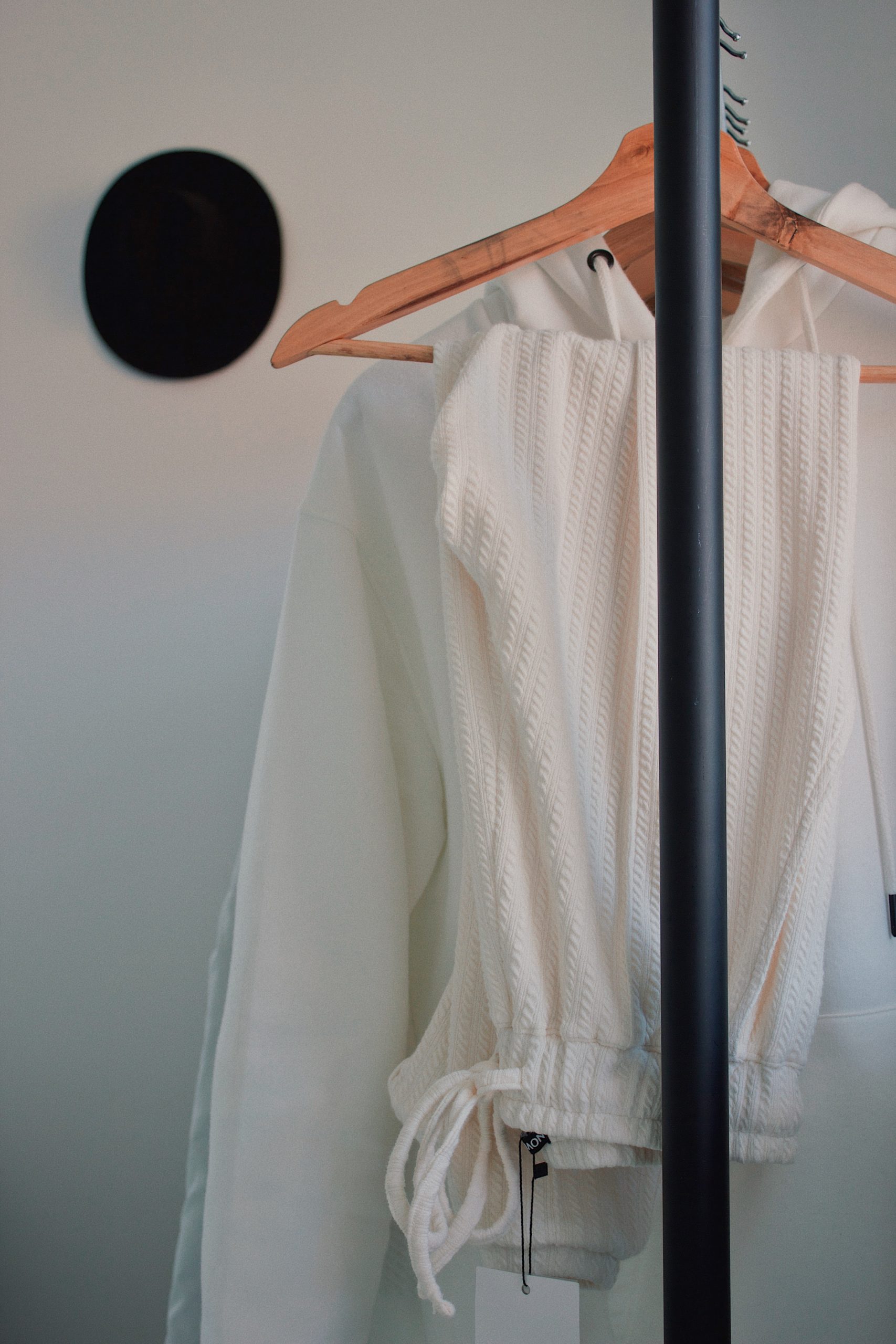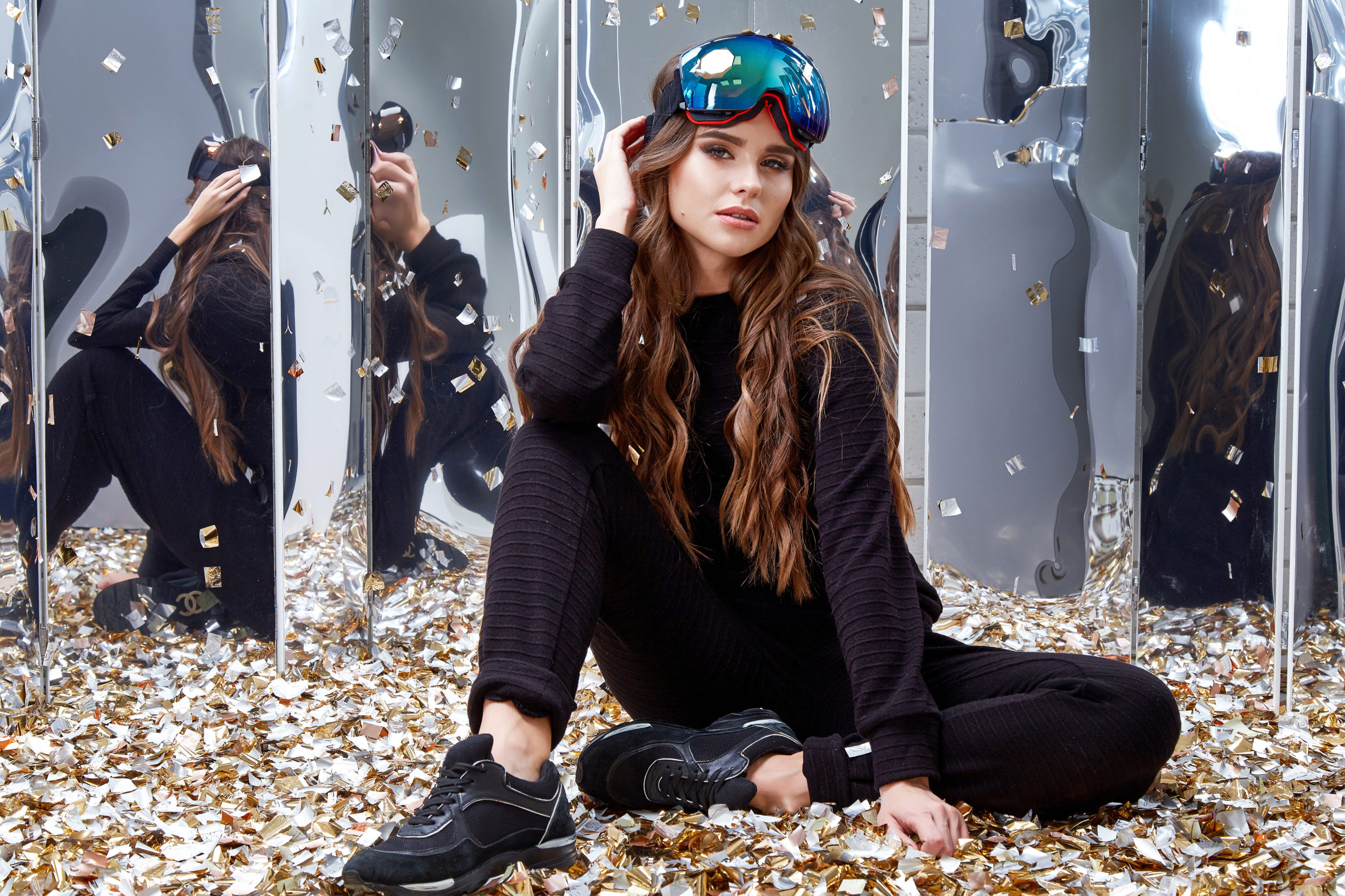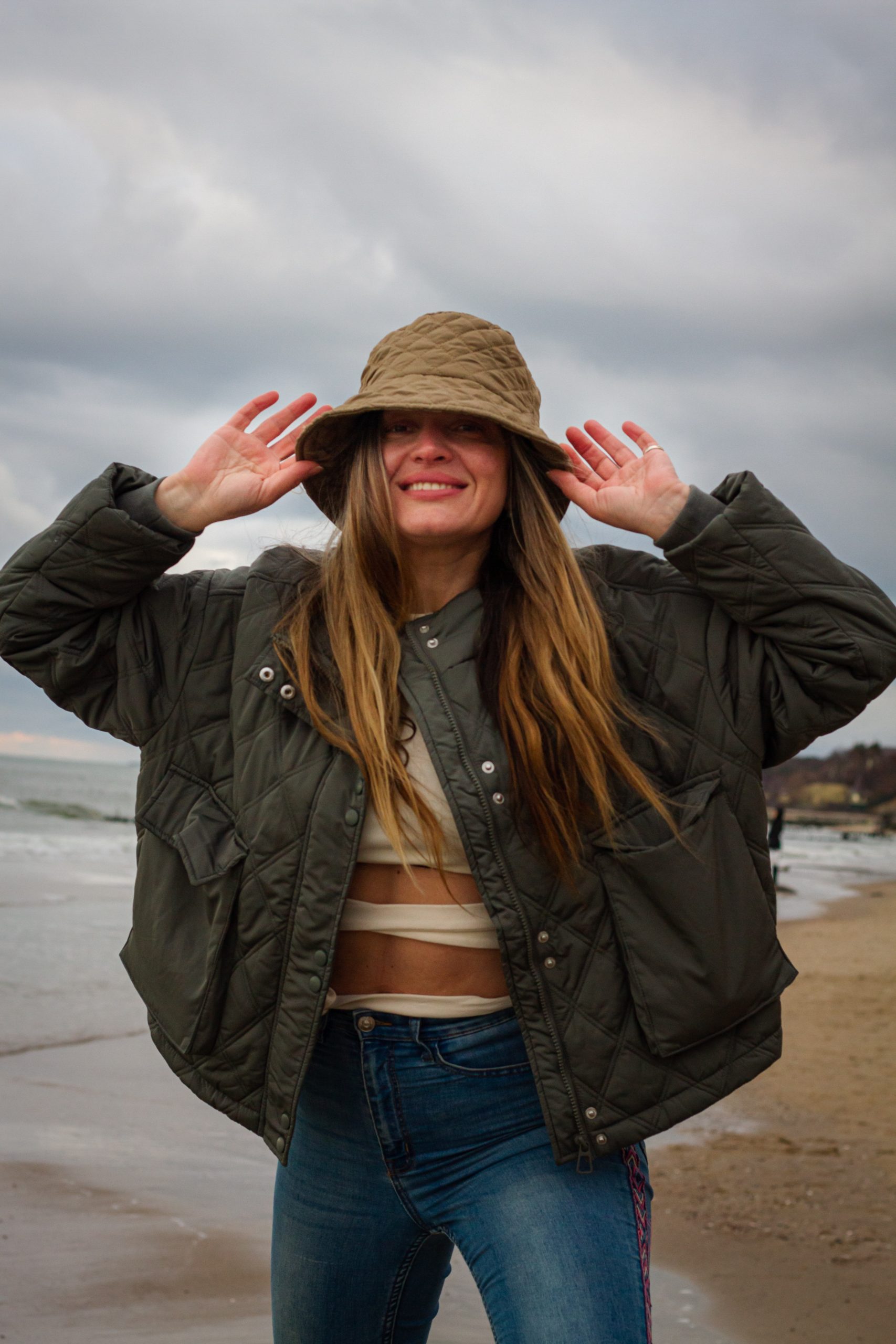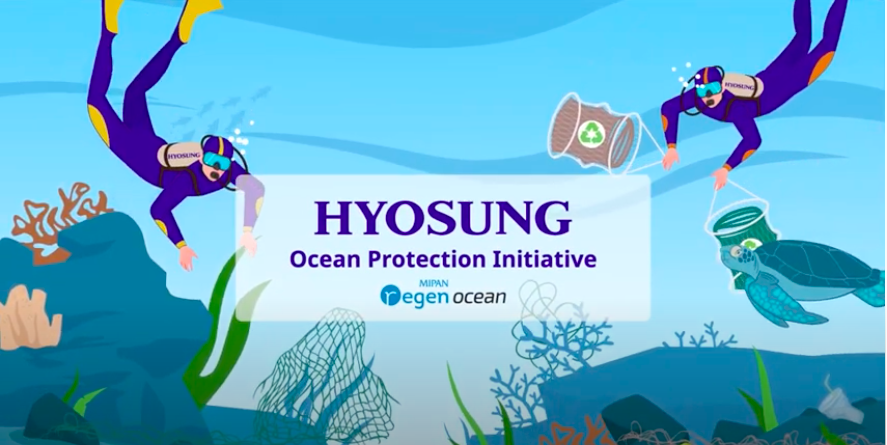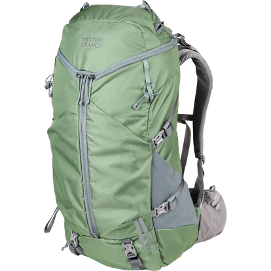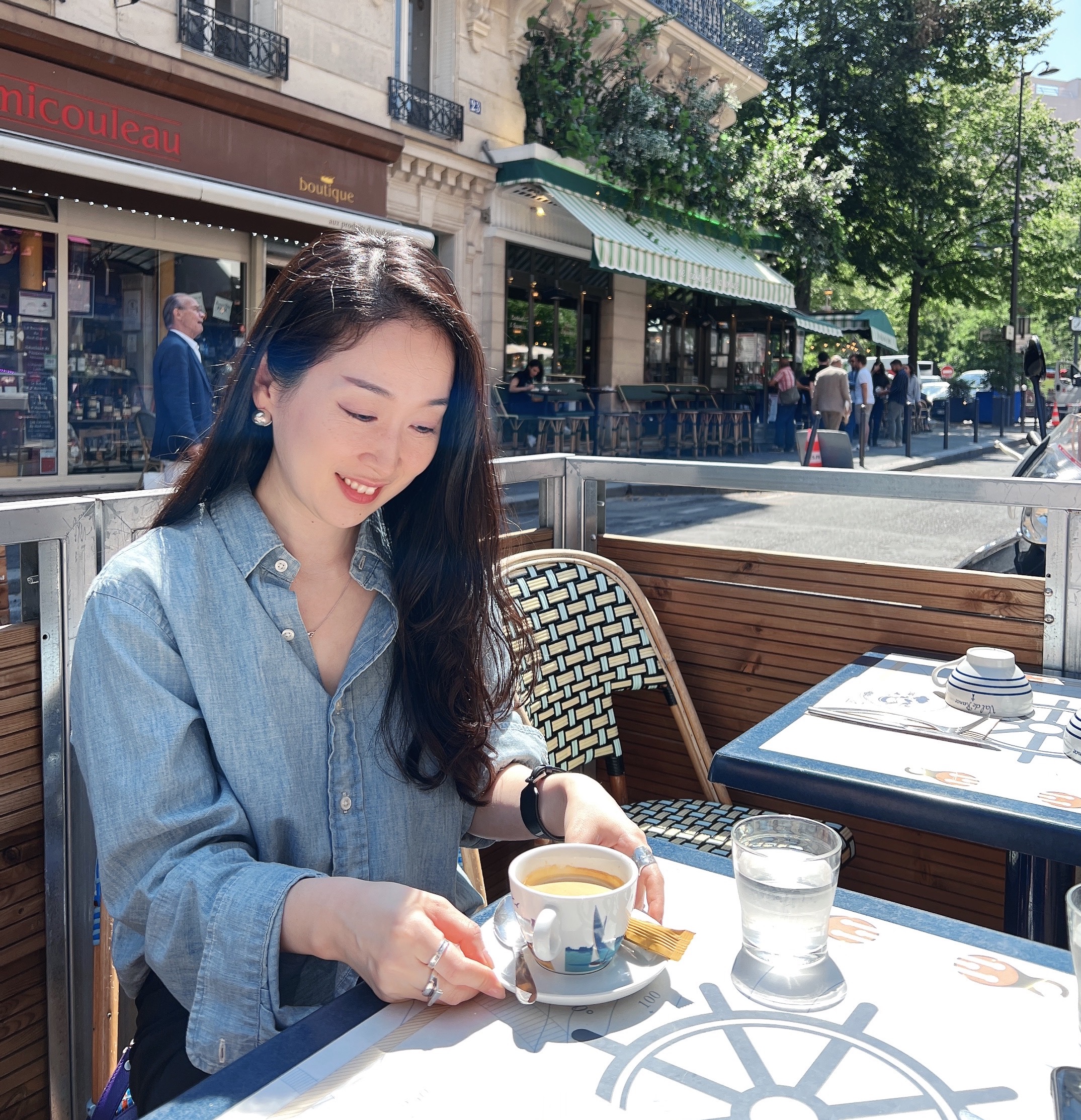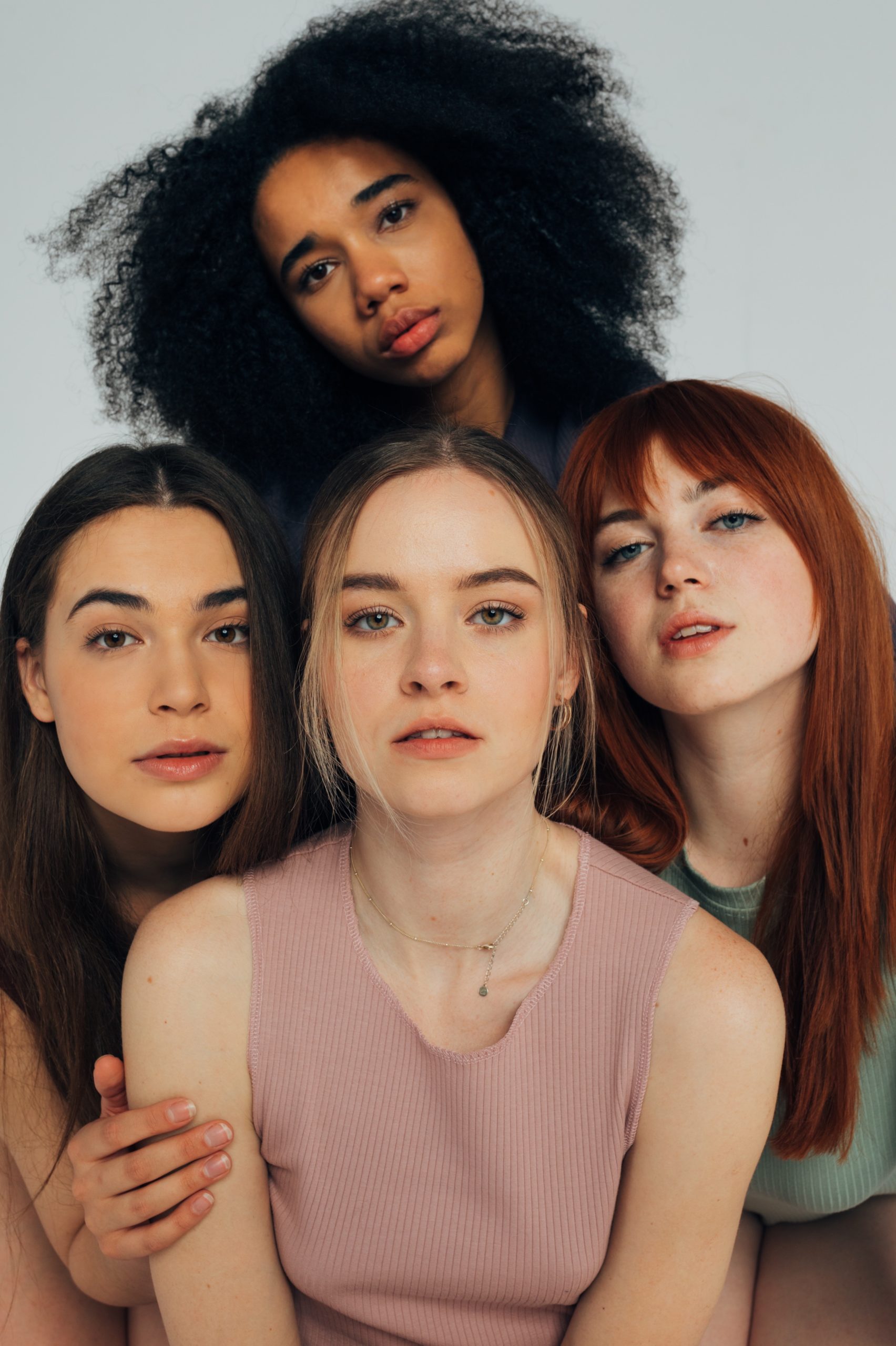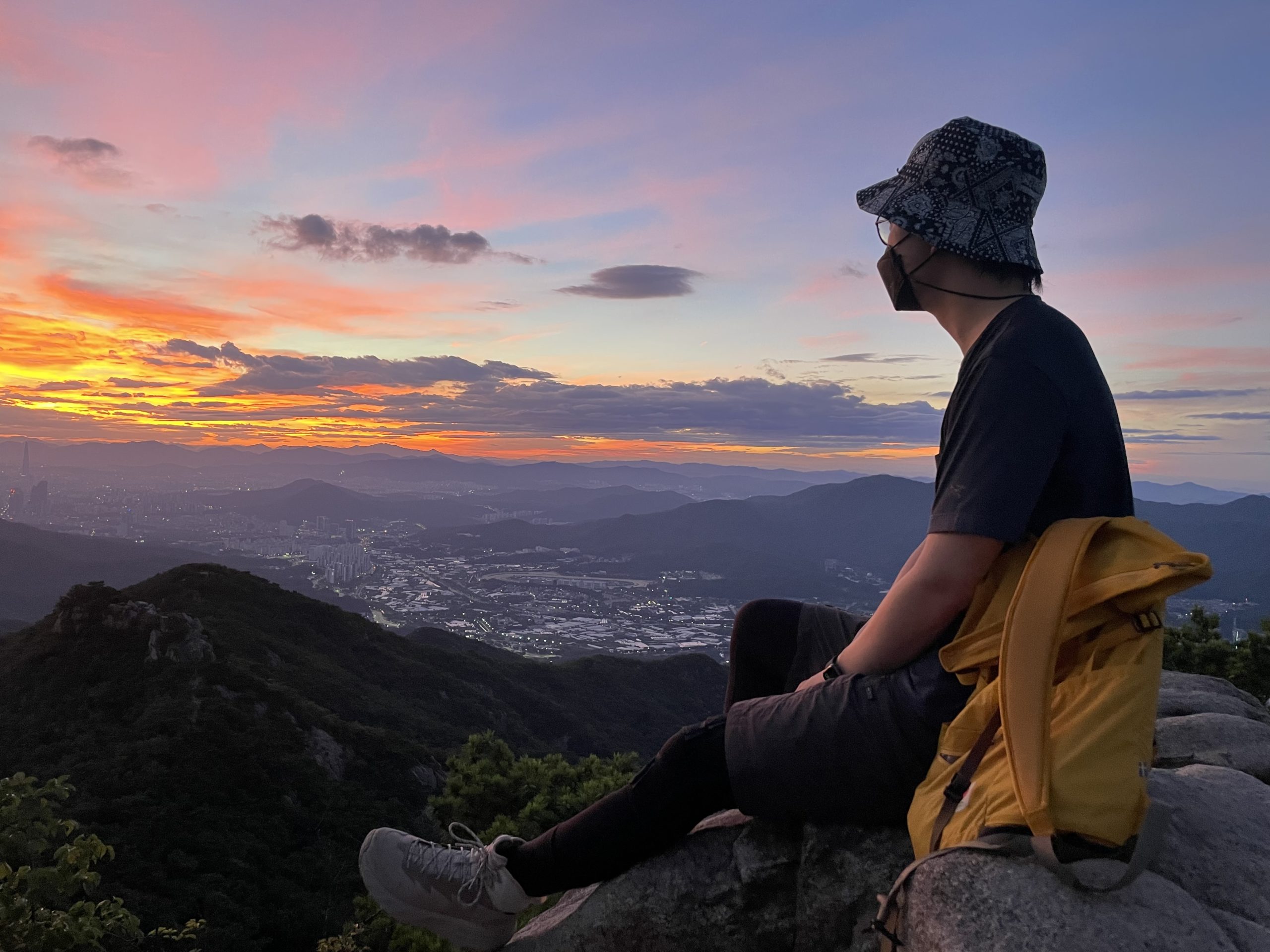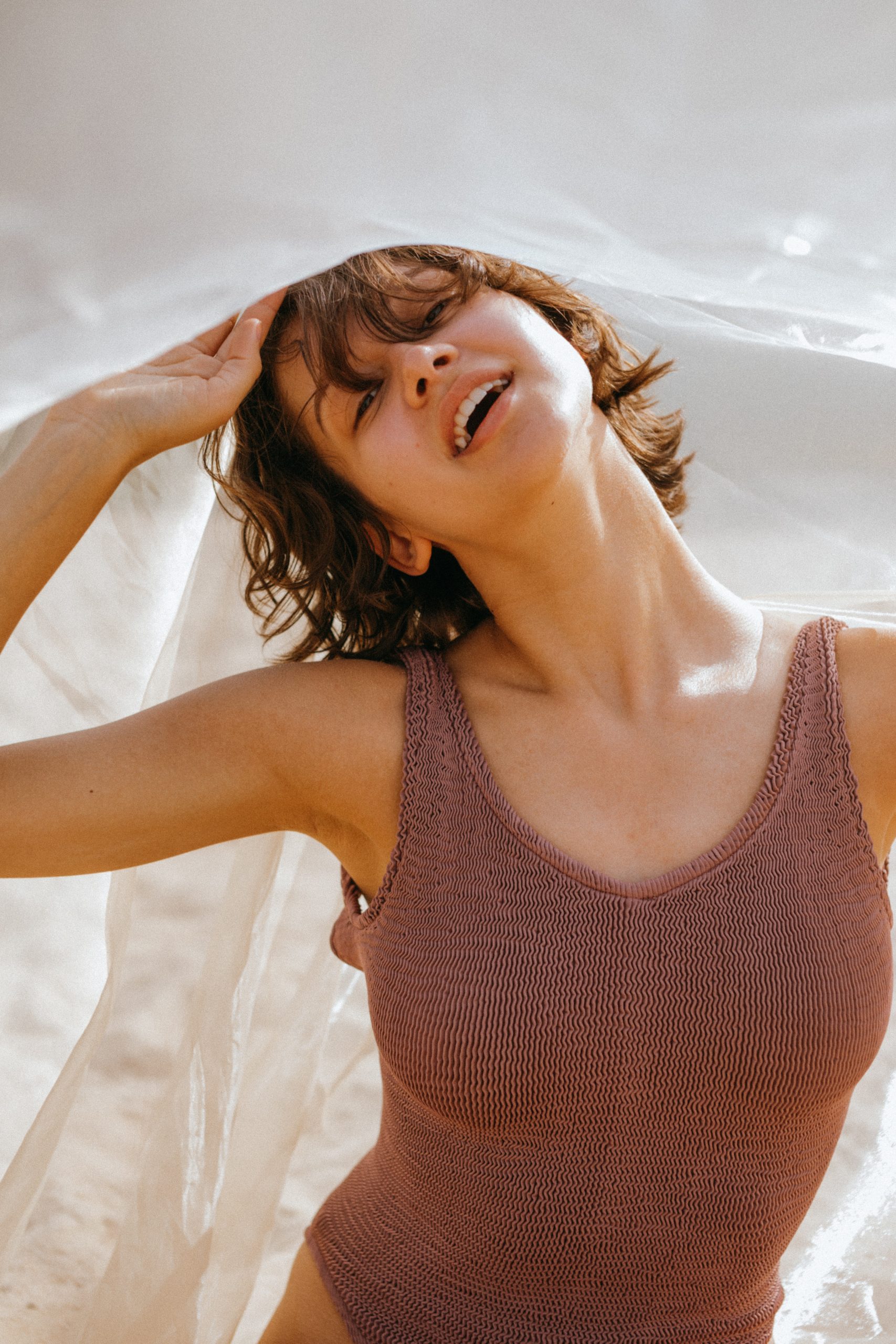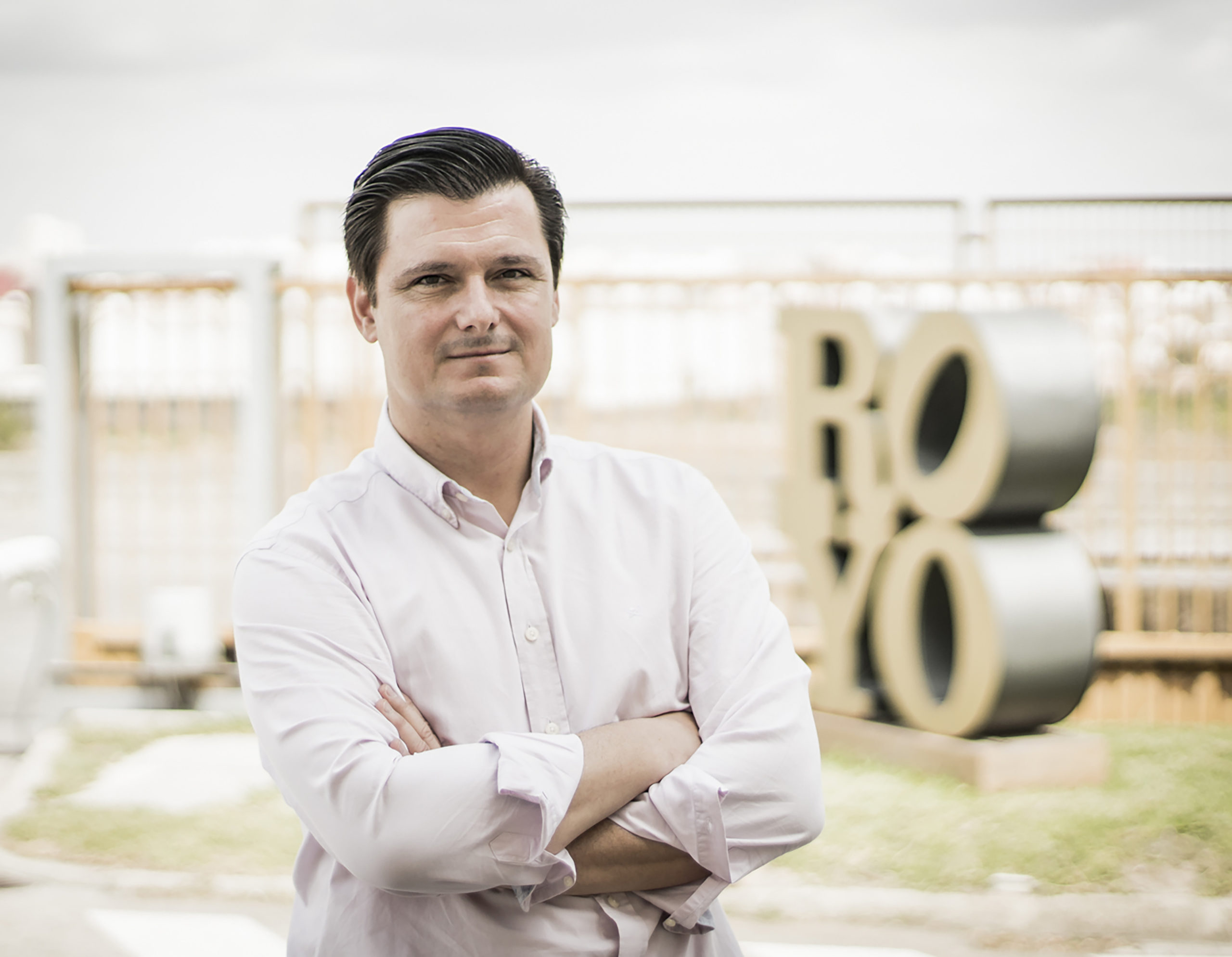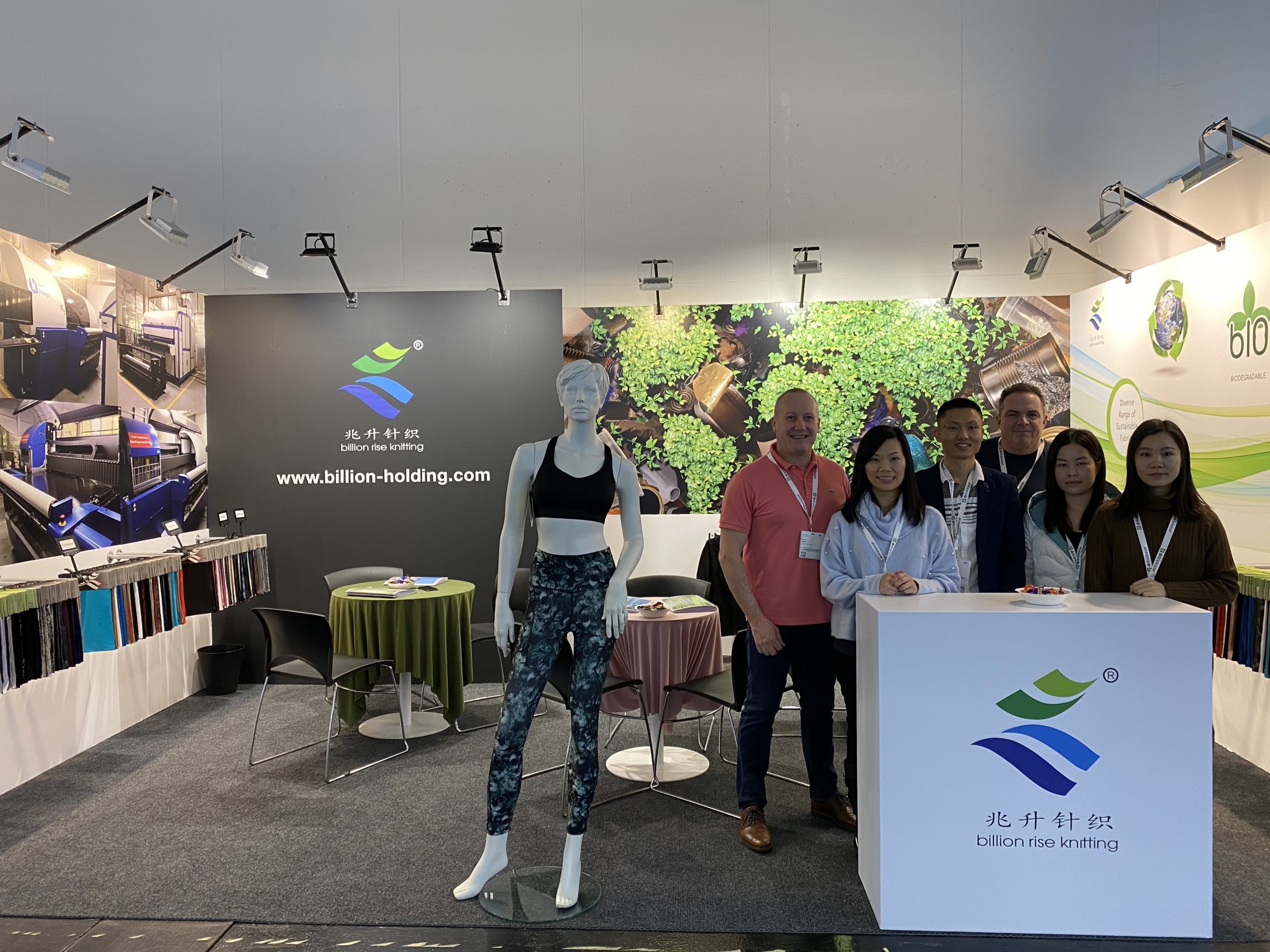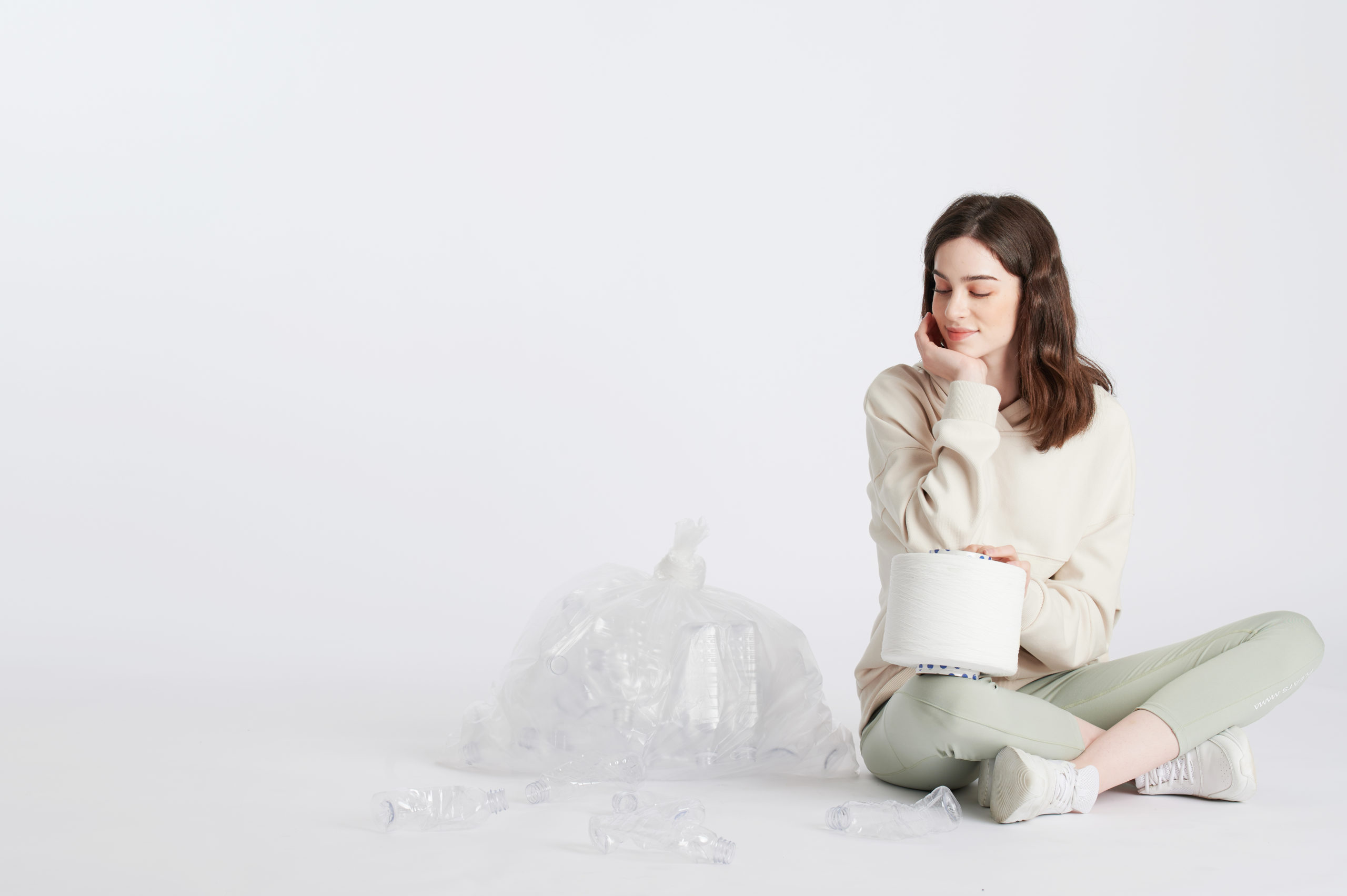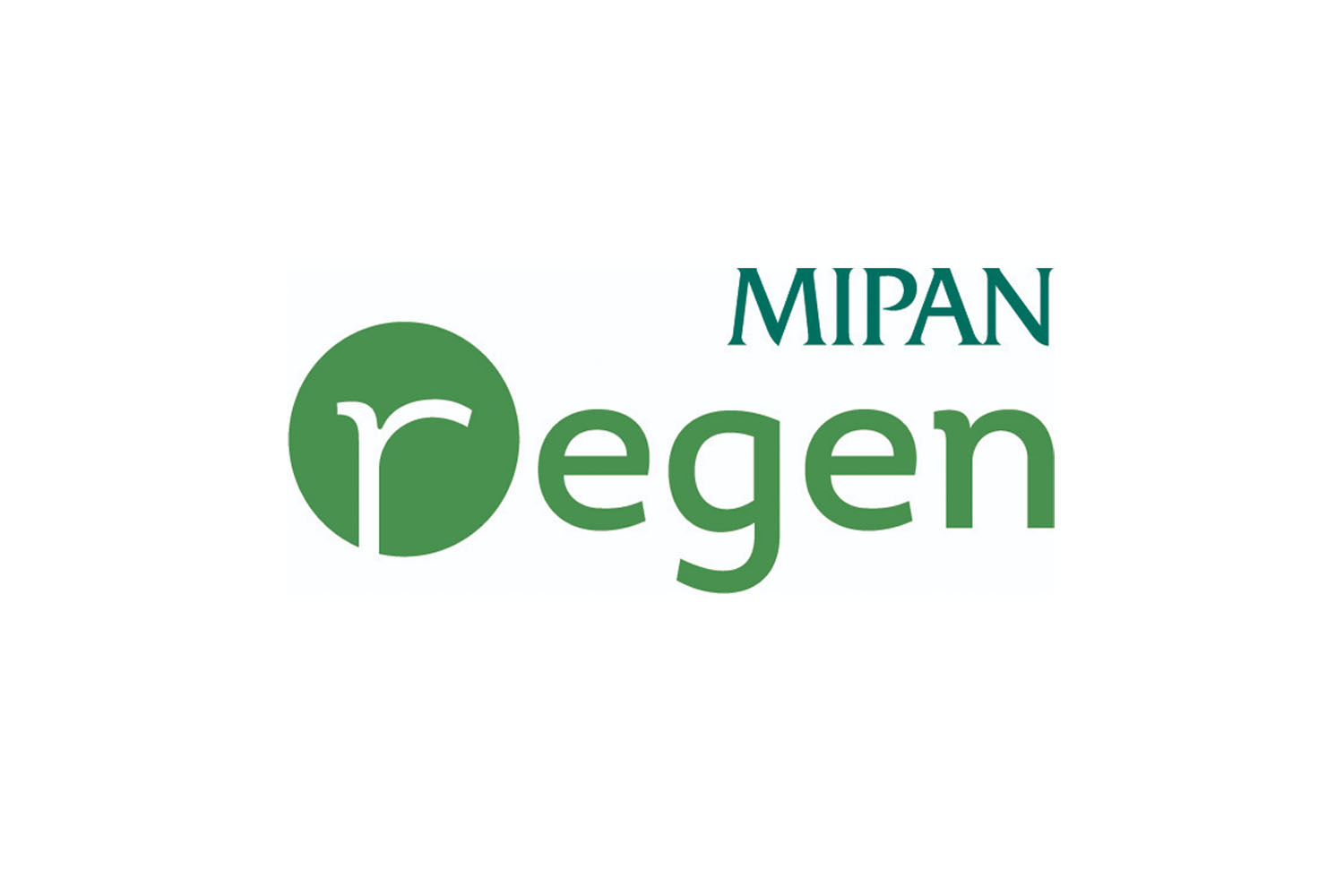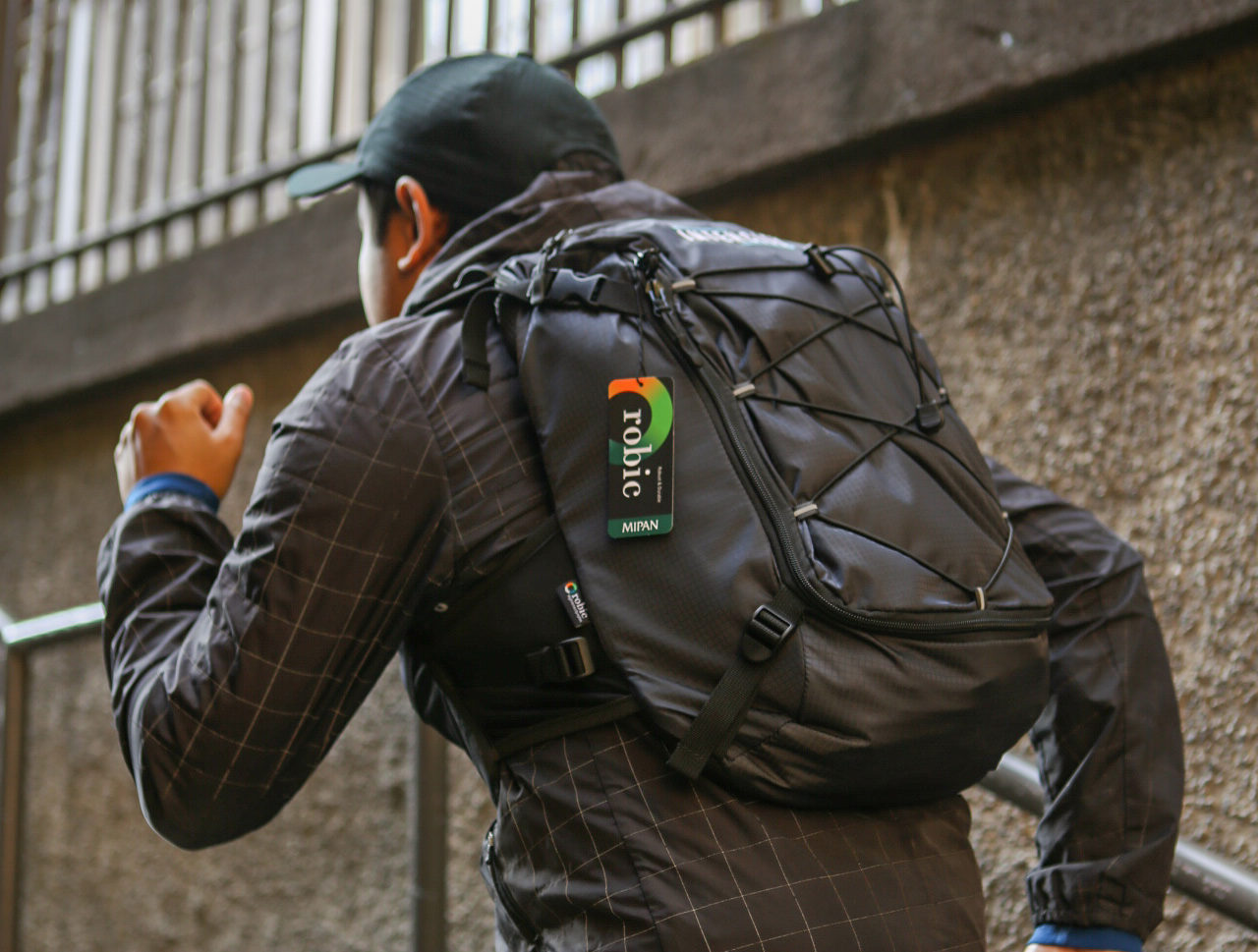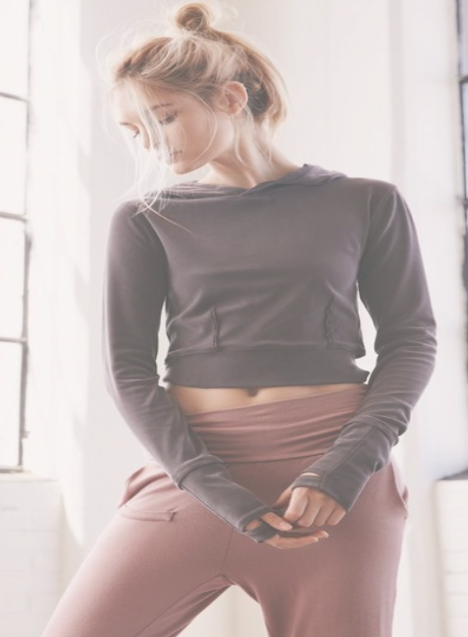Introducing Ruth Kelly, Head of Materials and Materials Editor at SSACHS
We had the pleasure of recording a conversation with Ruth Kelly, head of materials and materials editor of SSACHS, a design agency for performance and active lifestyle apparel, which also publishes a digital magazine under the same name.
Passionate about performance materials, Ruth is a creative fabric expert, thought-leader and educator. She has successfully led raw materials teams in the UK, Canada, Hong Kong and Sri Lanka all across the supply chain – from performance brands such as lululemon, to manufacturers.
Ruth combines her network of connections with practical in-depth knowledge of the fabric development, sourcing, validation and production processes to make ideas come alive. One of these connections just so happens to be Hyosung, where she and our team have collaborated on several material developments over the years.
In our conversation, we discuss a range of topics from how she left her corporate job to join SSACHS with her partners, to how she approaches materials development. We hope you enjoy!
A full transcript of the conversation is below.
Nancy: Ruth, thanks so much for joining me. I’ve heard so much about you and glad to finally chat.
Ruth Kelly: Well, thank you so much for having me, Nancy. I’m really excited to have a chat and share some of my thoughts and stories.
Nancy: Yeah. Wonderful. I’ve done a bit of research on SSACHS. Am I pronouncing it correctly?
Ruth Kelly: Yes, you are. Yes.
Nancy: Okay, SSACHS. Can you tell me how you got involved? It’s such an interesting business with the design and the magazine.
Ruth Kelly: Yeah. Well, it’s been an extremely exciting journey. We’re just at the beginning of that journey still. How I got involved with my two business partners, Diane and Soudi, who are both in the UK, although we’re all British, it was actually the powers of LinkedIn and connection and networking that got us together, because a bit like yourself, Nancy, we’d all been existing in parallel worlds throughout our careers, having worked in sportswear, in big corporations, the big brands.
Diane reached out to me on LinkedIn and was like, “Hey, Ruth, really interested in what you’re doing. I’ve got a magazine. Would you like to be interviewed?” Of course, as a new consultant in this world, it’s always nice to have someone who wants to interview you. It comes across a lot more authentic from a PR marketing point of view.
So, I jumped on a call with Diane and, law of attraction, we just hit it off so well that it morphed into an amazing conversation. I wanted to say an interview, but it wasn’t an interview or a job application, it was just a really cool conversation. We realized we had so much in common that I actually came off that call being invited to join the team and head up the materials section of the magazine.
So yeah, it was just having this lovely feeling of, oh, these are a great bunch of people they’ve got, they’re trying to do exactly what I’m trying to do, and isn’t it so much better to be part of a network and part of a team rather than trying to do everything by yourself?
Nancy: Absolutely. It just brings me back to, maybe we’ll come back to this, but one of the articles that you wrote for the magazine on collaboration and how important it is and how you can often do so much bigger things with it, and even though you have different strengths, but when you bring it together, it’s really powerful.
Ruth Kelly: Yeah. I always try and go back to the teachings of Richard Branson, because he always talks about that not one person can do everything and be super strong in everything. So that’s one thing I’ve learned is to be aware of what your strengths are, and also be aware of maybe where you’re not so good or you don’t enjoy things, and having that confidence to be able to let other people take the leads who are amazing at that, and then that’s where it’s so much better as a team.
Nancy: Absolutely. Was there a kind of a defining moment where the three of you… I mean, you had this call on LinkedIn, but I know you had worked with some very big brands in the past. Were you head of materials with some of these brands? Was there a time where you just said, “Okay, I’ve had it, and I want to do something on my own?”
Ruth Kelly: Yeah. Well, I wasn’t head of materials, but I was a director for lululemon. You know, like any big brand there is especially, I think, as well, when you work for a publicly traded company, there’s obviously another set of responsibilities and pressure to keep, quite rightly, well, you could argue about that, but that’s another podcast, but there is this pressure, anyway, to provide newness and more, more, more profits.
Having been working like that for seven years, it’s exhausting. It’s super fun, but there is an element of what I call a hamster wheel. Oh, here we go again. Here’s another season. And those seasons seem to be getting shorter and shorter and you’ll feel like yourself and your team have pulled out a miracle or done something really amazing, but it’s never good enough. It’s always like, what’s next, what’s next. So maybe that’s the cynic in me, being in the industry a little bit more, but I think coming into the twilight of my career, shall we say, not at the beginning, you start to look at things differently. So, it’s, okay, what can I actually do for myself to really create the life I love?
It was a big thing for me having to break those shackles of the monthly salary. So, being able to step out of that and, okay, how can I create financial stability for my family in a different way, in an entrepreneurial way? That is super scary, that is, and it’s taken me many years to get the courage to try and do that, but I found it’s extremely freeing when you do. You know, you kind of now think of, “Why didn’t I do this years ago?” Right? But it’s been in that mindset of, “Oh, I always need to work for someone else. I need to get that salary to come in,” especially when we’ve all got responsibilities, et cetera.
So, yeah, I think that was part of the drive, and the drive to also try to make a change in the industry. You know, we can all sit and complain about, oh, I don’t like the fact that there’s all this pressure, or that things aren’t sustainable, or that I don’t feel I have a life, or I’m not producing great products. We can all get in complaints, but for me, it’s also, how do you be part of the solution rather than part of the problem? So also stepping outside of that enables you to have different conversations because you don’t have to put that on that layer of working for a company and have to apply their filter to everything.
Nancy: Absolutely. It’s very frightening, I know, but so rewarding. I have a feeling it will be interesting to see when we come out of the pandemic what will transpire with company work, what people do. I think a lot of innovation, or I hope lot of innovation, comes out of this situation, not just in product ways, but just personal ways as well.
I listen to podcasts a lot, and yesterday on my walk I was listening to Brene Brown and Daring Greatly. I’m just like, “Oh yeah, that’s why I did this.” I know it’s scary, but.
Ruth Kelly: Awesome. I mean, I was fortunate enough to see her speak. She was one of the keynote speakers at the lululemon Leadership Conference and she is amazing. She’s so much fun, as well. I think she was a little bit scared that she was coming to lululemon and that people were going to be, you know. Then, this was quite a few years ago, so early on in her public speaking career, so I guess she’s had her some experiences where maybe she tried to be a little bit goofy and people didn’t kind of get it. But of course, the lululemon team was totally into it and she had the whole room up dancing. Yeah, she’s awesome.
Nancy: Oh, she’s funny. Maybe we can get a little bit more into materials now. So how do you think materials influence design?
Ruth Kelly: Great question, Nancy. Yeah, this is something where it’s, to me, it’s a symbiotic relationship. I talk a lot about, with designers, what comes first, the chicken or the egg, and it can be both, right? So often it’s that influence of you pick something, you pick this material up, you have this tactile, it’s visual, experience. As a designer, you can get excited, you can start to visualize how that can transpire, how that can be used in a design and how it can create something that is going to, especially in sportswear, provide a soul and a function, and, okay, it might sound a little bit pompous, but actually enrich someone’s life by making them feel good, by making them not have to worry that they’re going to get caught out in the rain when they’re on a run.
So, yes, you can pick up fabrics and have that very visceral relationship with them and that can spark the design process. But then equally, there’s also the other way to look at things, the other side of the coin, where as a designer you might have an idea of something that you want to create and you can’t actually find the exact thing either visually or aesthetically that you want, or performance wise, that you need. That’s super fun as well, being able to work with a designer and help draw out their ideas, especially as they’re the experts, maybe, in apparel design, and you’re the expert in developing the fabrics and being able to do that.
I’ve also worked on other aspects where when I was at lululemon I did, a few years ago, a reflective embroidery collection. I was really interested in how that whole design and development played off each other. So, the whole project came to light because we were trying to innovate in the area of reflectivity. So, when you’re out on a run, especially in the fall in the Northern hemisphere, you want to be able to feel safe, and with reflectivity, it’s very technical, there’s a lot of limitations as to what you can do.
I had this idea, it was two o’clock in the morning, using my background from the intimate apparel world, I thought, ooh, what about taking this new reflective yarn that’s very difficult to knit or weave because it’s super stiff and applying that to an embroidery technique which is not normally used in sportswear. I kind of thought, hmm, I knew I couldn’t go to the design team and explain this because they kind of wouldn’t get it. They needed to see something. I could see it in my mind, but I knew they needed something to actually see.
So, as a side of desk project, went along and persuaded a company that I noticed was an embroidery company. “Oh, hey, if I can get you some yarn, would you just be interested in just doing me a little sample?” They’re like, “Yeah, yeah, sure. No problem.” So did that. Then when I showed it to our creative director, he was like, “Yeah, just go for it, Ruth, that’s awesome. Just go for it.”
Then it was the question of working with the design team to be like, okay, this is the potential, how can we actually engineer what we need to make the best use of this technology? So sometimes you also get into that realm where they are both influencing each other, and so that you’re doing the development of the material at the same time as the development of the garment. So that was super interesting to be able to make these adjustments on the fly as we fit the garment. Oh, we need that embroidery to go a little bit more up there. Let’s alter, let’s tweak, that design. So that’s super cool as well.
Nancy: Yeah. It’s symbiotic how you work together, and you really need both so one can feed off the other. What do you think is important to you when you create a fabric? Obviously, the yarn, what the fabric has to do, but do you just have like these brainstorms that maybe come from design or just like, “Oh, I have got to have an invention here?”
Ruth Kelly: Yeah, it’s a bit of everything. You know, for me, it’s like lots of different plates that you’re spinning at the same time. So, you have to have a real appreciation and a desire to produce something that’s aesthetically beautiful or handsome, or whatever that can be. That’s really important because you could be an amazing technical person but create something that just doesn’t look or feel great and nobody’s going to want to wear it. It doesn’t matter how great it is technically, especially when you’re putting something next to skin.
Then the other thing is, being a bit of a geek as well, a bit of a technical nerd, as you said, it’s about getting into that detail of the fibers, the yarn, the number of filaments that’s in there, the construction, the finishing, the amount of stretch, all these different parts of the recipe. It’s a bit like baking a cake that you’re playing around with, and it’s fascinating how they all inter-react to the good or detriment of the overall finish.
A third element is also the commercial aspect that you need to ask, is this a commercial product? What does that mean? How can I get that into mass production? Then, of course, don’t forget sustainability as well. So that’s a very important new fourth place that we need to keep in there. Am I producing something that is going to be sustainable? I mean, that’s a whole other debate, but at least am I producing something that is going to be part of someone’s closet for a while. It’s going to be durable. It’s going to be something that they’re going to treasure. That’s really important to me as well.
Nancy: Speaking of sustainability, it means so many different things to so many different people. What does sustainability mean to you?
Ruth Kelly: Well, I think the first important thing to think about is from a design point of view. Because we can talk about circularity of design, we can talk about recycling, et cetera, et cetera, but as I said earlier, it has to be sustainable in terms of it has to be something that we all produced and that it’s going to be treasured and loved. Because if you think about circular design, or end of life, you’re talking about you’ve already built in this obsolescence into the garment. You’re already thinking about end of life. But what if something was so treasured, such good quality, that it isn’t wearing a way, but also it isn’t becoming obsolete because it’s no longer in fashion or it’s no longer considered aesthetic?
I don’t know, maybe I’m an idealist, but I think the more that we can do to that, that is going to be huge, and we definitely need to look at our level of consumerism. So, I think, yes, everything else is part of the solution. Recycling, biodegradable, waterless dying, using renewable energies in factories, like all of these are super, super important, and we also need to look at the amount that we consume and the amount that we produce. So, for me, it’s about producing better and producing less. That doesn’t necessarily go with a consumerist or a capitalist culture, so again, we’ve got this…right?
Nancy: Yes. No, and I’m hearing that from other guests on the podcast. I think that’s a fabulous trend. We all have too much stuff and if we can buy better and wear longer, that would be better. But you’re right, consumerism. When you’re designing all these different seasons, you have to keep coming up with something else and something more and something more. So, it will be interesting to see what happens.
How do you think the supply chain has been helping brands with their sustainable efforts?
Ruth Kelly: I think that’s a really good question. I think there’s good and bad. I wouldn’t even say bad, it’s just really hard. You know, it’s hard for us all to figure out and to really tell the authentic stories. People, quite rightly, are cynical about, “Oh, it’s just greenwash. Oh, here we go again. “If I look at the mill, say, and they do a better job than others at telling the stories. It can be confusing because sometimes their salespeople aren’t always maybe the best technical and don’t know the story themselves.
One thing I’m sure you’ll appreciate, Nancy, that can be super confusing is even something as simple as the recycled yarn. The fiber supplier manufacturer might have yarn beyond the plant and might give it their own brand name, and then the mill wants to give it another brand name, and then everybody gets really confused, you know? I found out fabrics that I had been working with for years, have actually got a component of a Serona yarn, and I didn’t even know, right?
So, I think we can do a lot better. I think, certainly from the mill level, people are really trying to do good and they are really trying to help the brand. You know, it’s been tough for them because when we started these conversations years ago, it was always about price and people wanted the sustainability aspect but didn’t want to pay anything extra. Now, that price difference is still there, but it’s becoming much, much smaller.
It’s going to be interesting to see in terms of smaller dye batches and things like that, how we can carry on. Because there’s so much waste with minimums and lot of dead bolt stock, that type of stuff. There are some great group buying platforms that are out there now for smaller brands or people where you can actually buy our redundant stock, so that’s a good thing. But yeah, still lots to go.
Of course, some great research that’s going on at the moment in different materials, looking at adjacent industries and looking at their waste and can that be used as a feed stock? So, I think, yeah, it’s a very complex journey, and we’re just at the beginning and there’s no silver bullet for any of us in this.
Nancy: Yeah. Just trying to do the best that we can.
Ruth Kelly: Yeah, and just ask questions. I always say to people, be curious. Stay with the mill, but ask questions, be curious, be cynical, just keep asking and asking, and that’s how you learn.
Nancy: What do you think makes a good textile partner when you’re looking for materials or you’re developing materials?
Ruth Kelly: The number one thing is open and honest communication. I mean, I’m assuming here that you’ve got the technical know-how, right? That’s a big. So, I think it’s finding the right person who fits your business, okay? So, there are different suppliers that will work with different brands or different manufacturers, so it’s understanding their business model and seeing if it fits in with yours.
If they are geared to produce big runs and that’s what you’re looking for, awesome. If you want somebody who’s smaller and flexible, great. You always have to do your research to understand what their business model is, but also what they’re specialist in. Because a lot of mills, and I’m just talking about fabric mills here, specifically, but it goes the same for any textile partner, be it when you’re going further upstream looking at fiber or day stock chemical partners, is understanding what they’re best in the world at, right? Because they might have a wide portfolio, but they’re really good at this, okay? Maybe that’s what you want to focus in on.
But as I said earlier, it’s that open, honest communication that is huge. It just makes life so much easier. It’s also obviously up to yourself to be super clear on your expectations so that when it goes wrong, it’s often, as it always is in human life, about different levels of expectation and people not being clear on either side. Which when we’re dealing with different cultures, different time zones, that can be super difficult. Especially when you are at the beginning of a relationship with somebody it’s a bit like dating and it takes a while to get to know each other, but then hopefully after a while, you’re in a situation where you can be truly honest.
Even when you’re having to deliver bad news, which happens all the time, the partner feels that they can do that and it’s also going to be okay. It might not be the news that you want to hear, but they feel that they can actually explain the situation and give possible solutions and that you can work together to solve that. Right?
So, I think another thing that really good textile partners do is they do their research. They really understand their customer’s business and they’ve done their research. I’ve, throughout my career, sat through and, oh gosh, I don’t even want to think about how many times I’ve sat through it must be thousands of presentations and people sharing their range and you just know that they haven’t even looked at the store, they haven’t looked at the product. They’re just trying to hit all bases.
I get that. I get that there’s also the stuff in the store that was maybe things that were developed two, three years ago. They don’t necessarily know what’s in the pipeline or where businesses is changing. But really good ones do help the brands, help the retailers, make that connection of, oh, this is how I can use this product in my collection. This is the potential.
Nancy: Right. Help come up with solutions to your problem.
Ruth Kelly: Yeah. Yeah.
Nancy: Exactly.
Ruth Kelly: So they might have this like amazing new fabric or new technology, and they’re saying to the brand, oh, we’ve been in the store, they might reference a particular garment that they’ve got, and they’re saying like, “This could be your next wild in the wind jacket.” Right? This could be, I don’t know what that is.
Nancy: It’s very good. I like it.
Ruth Kelly: I know! Wild in the wind. But yeah, they might have even made a comment or done some sketches. Again, it’s just planting that seed and helping them make that connection. Because I often say to people who are presenting to the big brands, you forget, these people that go in from meeting to meeting, they might’ve been in meetings for 90% of their day. They might not even have had a chance to go to the bathroom or eat anything. It’s hard to change gears sometimes and suddenly get into that space, you know? So, you’ve almost got to do their job for them and make it easier as to how they can see the runway. You’re laying the runway out for them.
Nancy: What textile brands and mills do you think are doing a good job with innovation right now? Am I putting you on the spot?
Ruth Kelly: Yeah. I don’t know. Obviously, we’re at a confidentiality point in time a bit, right? That’s always a difficult one. So, there’s lots I could say there, but, yeah, I’m a bit loathe. I can give a little taste of what we’re doing at SSACHS is I put a curated list of my favorite fabrics for spring and summer ’20, and we’re just in the process of getting those photographed. We took into account the ISPO color trends and things like that. So, yeah, it’s my favorite fabrics that I think I’m really excited for sportswear from in there.
Nancy: Well, we’ll have to just wait and look at the magazine or online. We’ll have all that information in the show notes, as well.
Ruth Kelly: Awesome.
Nancy: So how do you think the pandemic has influenced design trends in technology?
Ruth Kelly: Oh, massively. You know, obviously, stay at home has really influenced my field of expertise in technical sportswear. Look at fashion, right? People don’t need a nice new dress to go to a wedding, maybe, or they don’t need that prom dress, unfortunately, or whatever. So that’s a real obvious one.
I think it’s accelerated and amplified what we were already seeing. We were already seeing this extension of comfort. So using all of that expertise that has been around in the world of intimate apparel, swimwear, sportswear, for many years, understanding what comfort, what movement of the body is, and the interaction between fabrics, the interaction between the body when it sweats, all of that, we’re just seeing that further being amplified in terms of if you’re nonactive. I was saying inactive. We’re always active. We’re always moving. But in terms of non-true high level sportswear, so that comfort, you know? But also, not losing anything in terms of aesthetics. So yes, back in the day, we always had our big baggy sweats or whatever that you would never be seen dead in, but there is so much more of this fusion of function and fashion and comfort now, and I just see more and more of that.
It’s interesting, from what I observe the industry has become very polarized. People are either doing really well, especially if they’ve got this kind of model and if they are doing e-commerce, and then you’ve got others that are maybe struggling so much. It’s going to be really interesting. As you said earlier, the innovation has been in how people work and processes, how they are using digital tools to develop. It’s going to be an interesting journey to see how it goes on.
Of course, I don’t think we’ll really know until the beginning of 2021, because a lot of the collections were all in the pipeline, so some were canceled, as we know, some were rearranged, so we won’t actually know the true fallout of what’s happening until the beginning of 2021, as well.
Nancy: Right. Right. What digital marketing techniques will remain, do you think, to help suppliers connect with mills, brands, post-pandemic?
Ruth Kelly: I think it’s been interesting. You look at the virtual trade shows, I think, that’s happened, it’s not been completely easy. There’s been limited success. I know I felt bombarded as an attendee, and a lot of the pure joy is about the networking, is about the touch and feel of the fabrics. Yes, there’s been some great talks and webinars, but again, we all start to feel bombarded from that. I’m not so sure how that’s going to carry on, I’ll be really honest.
There is an amazing company down in LA called Preface who operate in the fashion space. They took a very novel approach and decided… Sorry, to back up, they’d just started to do some what they call boutique trade shows out of LA and New York. When the virus hit, they decided to have a different approach and to actually present the season, or present the show, in a box to their customers. So, they didn’t even try and do a virtual show. They didn’t even do a webinar series. They did a series of talks, of panels, of workshops if people wanted it, and they delivered in a box to their customers a pre-curated collection of fabrics, of colors, of some of the smells and things to influence over the season all with a sustainability aspect of it. I thought that was super smart and really worked for that segment. That was a different way to approach things.
Nancy: It’s almost a bespoke effort, like they were customizing.
Ruth Kelly: Absolutely, yeah.
Nancy: I wonder if that’s going to happen more. It’ll be interesting to see. I’m hearing the same, that trade shows, I don’t think these virtual shows, as hard as organizers are trying to make them happen and I give them so much credit, they are just not quite the same. They’ve had to work so quickly to try to develop these platforms, so it must be very hard on them.
Ruth Kelly: Yes.
Nancy: You kind of touched on this a little bit, but where do you think performance apparel trends are heading? You know, you mentioned you think that fashion as we know it might be dead, but if you had your crystal ball, where do you think performance apparel trends are heading?
Ruth Kelly: Well, I think from everyone I speak to, whether it be men’s, women’s, whatever, comfort is still a thing. That’s not going away anytime, just more and more of it. I think there’s going to be, again, more on the sustainability side.
There will be more things that are actually coming to commercialization. Again, all these amazing things that are happening – take natural dyes for example. Because they are available, right? You can do that, but how can you really ensure that you take the variability out of them? So, there are people working on that and there are people working on bio-plastics. I mean, we all know about mushroom leather and all those sorts of things. I see that there’s going to be more and more of that.
I think it’s going to be interesting when we look at when people start to think about microplastics and what’s happening there. We have already seen fabrics being engineered that claim to have less microfiber shedding into the waterways. I think that’s a huge area that people will start to really see some solutions there.
So, I think it’s going to be super interesting. Everybody, from what I’ve… not everybody, but a lot of people, what they are wanting to do is to have, their ideal textile would be something that has the true performance, a full performance of a polyester or a nylon. Well, actually the performance of a polyester, the handling of a nylon, and look of a natural. Right? And completely sustainable and biodegradable. So, if you could do that, you’re on the way.
Nancy: Okay, get at it, Ruth.
Ruth Kelly: Yeah, okay. Right?
Nancy: Well, I know you’re not only a material developer, you’re a writer, a yoga teacher, lecturer. I mean, I was going to ask you if you weren’t doing any of those things, what would you be doing?
Ruth Kelly: If I wasn’t in any of those things, what would I be doing? That is a great question. I think I would be either an archeologist, because I’m just a bit of a history geek. I love anything like that. Maybe, though, I don’t know if I could sit for hours and hours in the dirt. My other choice, to go from dirt to water, would be a Marine biologist.
Nancy: Interesting. Interesting.
Ruth Kelly: Yeah. Yeah. I used to teach scuba diving for many years, and I just love being in the ocean, so I think that would be the opposite.
Nancy: Oh, well, there’s still lots of years left, Ruth. So, what have you indulged in during COVID-19? Anything?
Ruth Kelly: Well, apart from the odd glass of wine and the odd chocolate, which I think we all have, what have I indulged in? I’ve indulged in my garden, my yard. That’s been awesome, just being able to spend time out there and getting a bit of fresh air. Working with the family, playing with the dog, and lots of reading. I’ve had lots of time to do lots and lots more reading, as well, which has been great.
Nancy: That’s great. Yeah. Well, it’s been difficult, but there are some silver linings for sure.
Ruth Kelly: Absolutely. Absolutely.
Nancy: Well, Ruth, I can’t thank you enough. I really enjoyed our talk. We’ll put information on SSACHS on our show notes. I hope that we can meet in person sometime soon.
Ruth Kelly: I hope so, too. Thanks.
Nancy: Thanks, and have a really great vacation. Okay?
Ruth Kelly: Thank you so much. You take care. Bye, now.
Nancy: You, too. Bye.
For more information on SSACHS design agency and magazine, please visit https://www.ssachsagency.com/







